Maja Voje's Blog
October 10, 2025
How AI Agents Actually Go To Market
Dear GTM Strategist,
We heard it all - haven’t we?
“AI killed PMF.”
“AEO - the end of SEO?”
“AI replacing humans in GTM.”
“AI polluted inbound and outbound dead.”
😴 I am getting bored …
While everything is burning and nothing seems to work - I find myself busier than ever and a little more interested in things that work than those that don’t 🤷. How about you?
Over the last 18 months, I’ve been working almost exclusively with AI products and supporting 37 AI agents in their go-to-market endeavors.
In this post, I’d like to acknowledge and demonstrate 4 key differences between the launches of AI agents and our traditional SaaS GTM playbook, which we have been using for the last decade or so.
I’ll walk you through 4 key lessons from my $200M ARR AI launches that worked well for the teams I work with:
Sales-led for the win in early stages
Pricing: think beyond credits
Ecosystem marketing creates leverage
AI-first GTM is how these teams win
For each, I will provide you with a case study/example, practical frameworks, and action points that you can apply with your team to AI agent launches (or even other products/services) if you see fit.

This newsletter is sponsored by ZoomInfo.
85% of enterprise sales reps manage their book in spreadsheets. Only 5% use CRM.
This isn’t laziness - it’s survival. When deal data is in Salesforce, calls are in Gong, and content is scattered everywhere, spreadsheets become the only unification layer.
ZoomInfo built ZoomInfo Copilot Workspace to fix this: one workspace with complete buyer context, CRM data, and intelligence on 100M+ companies. No more tab-hopping.
Execution wins deals. Everything else is just preparation.
 1. Sales-led for the win in early stages
1. Sales-led for the win in early stagesI mainly work with technical founders and very product-savvy teams that have a natural tendency to go “product-led”. Ideally, they’ll launch the product, post on a couple of social media channels, and then people will love it so much that they’ll invite others.
For most, that is wishful thinking.
The cruel reality is that we have to grind through warm intros, upselling existing client base, doing “old-school” sales, or even offering “done with you” product+service combos to get past first PoCs (proof of concepts).
There are 3 reasons why “big adoption” - even if the team manages to get it - could lead to BIG problems when it comes to AI agents:
State of tech: in the beginning, our agent might not be “there yet.” Workflows and automation break, it sometimes glitches or starts to “act off.” That is not ideal for self-serve users
User trust: “earn the right to automate, keep humans in the loop” has been the mantra of AI agents adoption in 2025. We usually start with a smaller pilot and if things go well, we expand. Most of us do not just let 200 agents into our CRM to “dance around” and send random emails.
Real adoption - real costs. Even if we manage to create a buzz, what you’ll see is that most agents do not have “30-day free trial” 😏 - you have to qualify for a demo. Why is that? Because AI credits (tokens) cost money, and if we have non-qualified leads “playing around with the product,” their activity has a much higher cost than the “costs of hosting” from the regular SaaS.
Now that we understand the problems of “PLG for AI agents”, let me share one of the tactics that has been working well for nearly all the companies I’ve been working with (even for $1B+ ARR companies): outreach with a case study.
It is so simple that I’m bluntly stunned that more people don’t use it:
Select a beachhead segment (short tutorial here)
Solve a problem really well for a customer.
Find more customers like that and proactively reach out.
Amplify this with marketing, PR, and event activities.

Momentum, the GTM orchestration platform, has been very successful with this approach.
Their client portfolio includes ElevenLabs and 1Password and they raised $13M in a Series A round in July 2024.
Seriously, check out their website - it is a masterclass of using social proof to build trust and interest.
 www.momentum.io2. Pricing: Think beyond credits
www.momentum.io2. Pricing: Think beyond creditsAs a user, I dislike the lack of transparency in the unpredictability of burning credits. If I purchase 10,000 credits from you, please inform me precisely what I will receive: how contacts will be enriched, emails generated, and what benefits I will gain. Oh, you said that these tasks burn different numbers of credits - come on, I just need to understand how much it will cost me and how to budget for it.
We all love outcome-based pricing (so that we charge when the client actually gets value), but with most AI agents, we are soooo far from it 😕

If the following questions sound familiar, it is unlikely that the customer will agree with usage-based or outcome-based pricing; we’ll have to determine a fixed number and start there.
“How much should I budget for that in 2026?”
“Can we lock in this price per licence for two years?”
“How can you guarantee that the cost is not going up later?”
“How much work can this agent really take away from us?”
“We need a sign purchasing order and run it through compliance.”
“We require 10% discounts from all our vendors.”
Many teams that I work with would even consider offering a fixed price for “done with you pilot” - just to get a foot in the door and an opportunity to demonstrate value to the client.
My core belief is that pricing should be simple enough for a user to understand how much they will end up paying for something and it is our job to figure that out - not theirs.
This is why I loved old Swan’s pricing page - as someone working in GTM I understand how much it will cost me and what do I get - and I know exactly what package is the right for me.

I had a similar reaction to this pricing page by ElevenLabs that has 7 packages, but I still somehow understand what package I should choose and what is covered.

So please don’t make me do the mental math.
Help me figure out how much I should budget for it in 2026.
3. Ecosystem marketing to create leverageI was super inspired by the growth journey of HeyReach (ecosystem partner themself). One of their earlier segments was agencies, and you do see a significant spike in adoption/validation after they made this call. How so?

For most companies, outreach is hard, and they would rather do it with a trusted partner (agency) than DIY with one of 10,000 tools out there. Agency partners play a significant role in the customer journey for the adoption of these tools by many companies.
And if things go well, one agency can potentially bring in 10+ customers :) And that is not a pyramid scheme, it is a perfectly legit GTM motion called partnerships and much more - as we will develop and explain in the continuation.
Inspired by this beachhead strategy (target agencies for faster adoption), our client, echowin launched a white-label AI voice-building platform for agencies. Think about voice agents for a sec - AI receptionist, AI support agents … usually they are used by service businesses (car repair shops, restaurants, legal offices, energy companies, etc.).
For most of these companies, marketing and tech are not their core business activities, so many would outsource the work to specialized vendors - agencies that are their trusted partners for adopting new technologies.

They launched the whitelabel program silently, creating a website section and posting about it on social media. Within weeks, over 238 agencies applied, many of them supremely qualified, but the team decided to let them in in batches of 10-15. Why? To make sure that they are successful in onboarding their clients. The stakes are high - each partner can potentially bring in 30-170 locations - but first, we have to support them in building a great pilot. You remember... Lesson #1.
There is more to it. Miqdad Jaffer, Product Leader at OpenAI, introduced this wonderful model of 9 advanced distribution tactics that create massive leverage for AI products (he shared this in The Product Compass Substack - must read!).
Which of those would play well for your product?
 4. AI-first GTM: 7 PLG loops for AI products
4. AI-first GTM: 7 PLG loops for AI productsAnd then, once you successfully grind through the first case studies and create a value delivery process, it makes your company “the factory of case studies” and figure out where leverage could be created on your customer journey - by all means - go BIG!
For AI products, we do not have 6-18 months to achieve go-to-market fit.
We have weeks, sometimes months, to find a proxy for product-market fit.
The AI technology landscape is changing rapidly, investor money is shifting the cards really fast and customer needs and preferences are maturing. The barriers to entry for the industry are low, as soon as new players smell some money.
At this stage, it is crucial to accelerate adoption and consider moats and defensibility.
Miqdad Jaffer proposed seven PLG (Product-Led Growth) Loops for AI products that beautifully translate to agile companies.
Whenever we are discussing PGL and growth loops, think beyond “Free trial/free version”, “let’s go viral” and “share/invite a friend to get X” incentives- that was great in the 2010s. With AI, every query and output can become a distribution.
PLG in AI is no longer just about virality—it’s about compounding adoption. A single user generating value should create visibility, data, or incentives that attract a new user without requiring additional marketing/sales spend.

Each one of these loops follows the same pattern: usage → creates value → attracts new usage → strengthens the moat.
Which one do you think would work for you?
Cool - hope you got tons of value out of this one.
While I was writing this, my friend Aakash Gupta just sent out this chart in his newsletter on how Claude Code hit $500 million ARR in four months.

With two product managers and zero marketing dollars.
The pace of change is unseen. We have to adapt.
I’ll be doubling down on my sales skills, think about AI growth loops, and ask all my teams if we can run some usability tests on their pricing pages with our ICPs 😀 and I’ll definately figure out some other interesting leveraged distribution opportunities for my teams.
How about you?
To wrap this up, I also recorded a new demo of my popular GTM Power Hour ⚡️ framework, with an AI agents example:
Let’s exchange more best practices in comments, and if you are interested in templates, workshops, prompts, and examples of how to apply these concepts, you can get everything in my 100-item GTM checklist 👇

📘 New to GTM? Learn fundamentals. Get my best-selling GTM Strategist book that helped 9,500+ companies to go to market with confidence - frameworks and online course included.
✅ Need ready-to-use GTM assets and AI prompts? Get the 100-Step GTM Checklist with proven website templates, sales decks, landing pages, outbound sequences, LinkedIn post frameworks, email sequences, and 20+ workshops you can immediately run with your team.
🏅 Are you in charge of GTM and responsible for leading others? Grab the GTM Masterclass (6 hours of training, end-to-end GTM explained on examples, guided workshops) to get your team up and running in no time.
🤝 Want to work together? ⏩ Check out the options and let me know how we can join forces.
October 3, 2025
How to Clone Yourself with AI (in 4 Steps)
Dear GTM Strategist!
In my career, I had to learn about some really hard-to-understand technical fields.
Smart grids, traceability with blockchain, dRAGs and RAGs, autonomous driving vehicles, cooling systems for computers, injection molding, pharmaceutical compliance, cloud vs. on-prem system engineering, data interoperability spines, and open information exchange protocols in healthcare, and we just onboarded a new client in the forensic source science space - I think you got the picture.
How did I (Business School Grad, lover of art history and canine sports) manage to grasp the essence of these massively complex fields?
You guessed it, I did whatever it took.
I understood that my ability to do well would be compromised if I “don’t get what the company does”.
I spent hundreds of hours decoding whitepapers, listening to sales calls, attending courses and trainings, conducting lots of research, and, if I was lucky, making friends with a technical person or a product manager who was kind and patient enough to mentor me or at least answer my questions.
 Me discovering computer liquid cooling (as you could guess, it was in 2020 😷)
Me discovering computer liquid cooling (as you could guess, it was in 2020 😷)Domain knowledge can be challenging to grasp, especially for individuals working in marketing, sales, and growth who lack technical training or prior exposure to the field. However, it is necessary. Domain knowledge is mission-critical to craft effective messaging, copy, sales, and marketing materials.
In my experience, it takes an average marketer 3-6 months to grasp the field they are working in. That is approximately $15-30K investment for a company by still risking that this person will not stay or do well - that is a gamble.
Worse, I have met marketers and sales operators who were working 3-5 years in companies without understanding what the company does or meeting a single client in person, and that scares the s*** out of me.
Do people simply not bother to learn what they are working on, or are we as an organization extremely ineffective in providing them with accessibility, guidance, and motivation to learn?
And then one day, I realized I had become a leader and domain expert in my field.
Everything changed.
Now I was responsible for “empowering my people” to “get it” - to onboard them, answer questions swiftly and firmly. I had to balance the time and resources spent on “training them” and making sure that the work is done well, while doing 100 other things aside.
And just between you and I -
I often daydream about being able to clone myself.
I am slowly growing tired of repeating myself …
70% of questions are “on repeat”.
We go through the same loops, processes, and I have to do it with love, patience, and without the loss of enthusiasm, because that could seriously impact the motivation of my team.
Sure, I prepared docs - no one reads them 😱
Gen Z is not particularly interested in reading 150 slides and 70+ pages of whitepapers - I don’t mind.
At best, they throw them to ChatGPT and ask for a summary.
Wait - I can do that for them, and while I am at it, let’s make sure that the thing does not hallucinate and it gives them what they want - crisp, hands-on answers at midnight :)
In this newsletter, I’ll invite you to consider 4 forms of organizing your knowledge assets for better knowledge transfer in the company, power the processes with agents and ultimately - bring in the agents to do some of the work instead of you.
We’ll try to clone our domain experts 🙂
Step 1: DIY a simple Knowledge BaseEvery org that I’ve ever worked with has terabytes of data - presentations, documents, technical specs, videos … The knowledge is there - often even transcribed. So whenever a client comes and says “we have no idea what to post on LinkedIn” - I am like “send me the transcript of your last call/webinar or just dump me some docs and I’ll send you 10 edited LinkedIn posts in an hour or two.”
The problem is not that “there is no transcript of knowledge” in the organization - the problem is that there is too much of it, that it is not well organized, and that most people have no idea that it exists.
So the first thing you should work on is creating a knowledge base. This is not a “data dump” of all the possibly relevant docs you come across.
Rather, a knowledge base is a centralized repository where an organization’s documents, transcripts, presentations, and other content are stored, structured, and made searchable.
When enhanced with AI tools, the knowledge base transforms from a static archive into a dynamic resource - allowing you to instantly surface relevant information, repurpose assets into new content and formats, and dramatically reduce the time wasted on repetitive knowledge hunting.
One of the first things we do with our clients is create a knowledge base for inbound, so they can start producing content that makes sense in days, not months. This is extremely simple to set up, and you can even do it on the free tier of ChatGPT if you just learn how to utilize Projects effectively.

Another thing you can master quickly is in-depth research. My colleague Kyle Poyar did a wonderful job explaining this on his Substack, so hop over there if you want to research with ChatGPT and Perplexity like a pro.
Also, Kyle and I are doing the 2025 State of GTM Motions survey - please pitch in here if you haven’t yet!
Step 2: Create digital clones of your domain/subject matter expertsWe have reached the point of AI-agent development where I can not only “clone myself”, but also other domain matter experts, and serve operators in marketing, product, and support with reliable, swift answers exactly when they need them.
The hidden trap of being the “go-to” person inside a company is that your expertise gets consumed by repetition.
A typical Tuesday looks like this:
Answering the same questions dozens of times a week
Being pulled into every sales call for competitive intel
Rewriting the same explanations in email after email
It feels like supporting the team.
But in reality, it traps some of the most capable people in the company and prevents them from doing strategic, deep work that adds much more value than “answering to the same questions again and again and again”.
In companies with 3,000 or more employees, more than 450,000 hours are wasted each year on repetitive questions.
37% percent of employees spend over two hours a day searching for information that already exists.
That is the equivalent of 216 full-time employees doing nothing but asking and answering repeated questions for an entire year.
That translates into roughly $31.5 million lost annually for a company, assuming a typical U.S. knowledge worker costs around $70 per hour (fully loaded with salary and benefits).
One of the companies solving this problem is Scroll. Cornell University and Nikkei already use it to scale expertise across the company.
The process is straightforward:
Create an AI expert – specialization and setup take less than a minute.
Curate the knowledge base – upload documents, slides, call notes, and reports. The system learns from existing expertise, not fabricated data.
Share with the team – permissions ensure quality control while making knowledge widely accessible.
Enable instant answers – colleagues receive expert-level responses with citations, freeing strategic time for higher-value work.
Integrate with Slack – answers flow directly into existing workflows, without disruption.
Here is a short demo of how I built my knowledge base, integrated it into Slack, and invited the teams I work with to interact with it. It took me like 5 minutes to build it. Super easy.
Use the code MAJA2025 to get 2 months of premium access for free (Starter plan, $158 value)
Step 3: Tailor the value delivery to the user’s preferencesGreg Isenberg has predicted the end of the user interface as we know it. He explained the main difference between UX and AX (agentic experience):
 Source
SourceWhile predominant UX in AI atm is chat and “copilots”, experts predict that, like agents, future interfaces would become dynamic and tailored to users.
Every time that I say that I am a visual learner, it backfires, and someone will comment that there is no such thing as learning styles. But I know for sure that I learn a lot more from seeing images and watching videos than if I had to read through 80 pages (which is an irony because I am a long-form content writer and I have written a 350-page book).
I am not alone.
91% of employees want personalized training, not the cookie-cutter content they’re getting today.
Companies are losing $13 million for every 1,000 employees because training takes too long and costs too much. Most organizations need six months and a six-figure budget just to turn existing PDFs, SOPs, and slides into “courses”.
You know “courses” such as technical presentation of new products, medical training, compliance training, presentation of new “exciting” regulations on one of key markets by legal, safety at work … Most experts that have to deliver them are not specifically keen on doing that and have little to no training in how to deliver knowledge effectively - spoiler: 6h workshops and 200 slides is not always the answer
I am working with NovaSkill AI - an LG venture that tackles the problem of organizational learning at scale, tailored to user groups.

Here is a demo of how we transformed a clinical poster for a medical device company into an AI-narrated, verifiable training course. Each learner can select how they want to absorb this knowledge—video, podcast, reading the document, etc.—and there is a copilot that acts as their mentor. There is no room for mistakes and hallucinations when it comes to such training; everything has to be bulletproof and verifiable in the knowledge base.
See how we did it:
Now, let’s unlock multiple diverse AI agents to work as a team!
(despite our better judgment 🤠)
Step 4: It is buzzing 🐝- Swarms of agents that work instead of humans (and are supervised by a human)Care not about the buzzwords; you may be more familiar with the terms “multiagentic workflows” or “teams of agents.”
In essence, we are discussing how you can utilize multiple agents to accomplish tasks autonomously, create new value, and redefine existing workflows.
Let’s be specific: echowin is a platform for building AI voice agents, such as AI receptionists. They have recently empowered Budget Power, an energy broker from Texas, to automate over 90% of their support calls, saving the company 40 hours per week - an equivalent of one full-time employee.

echowin enables a multi-agent workflow aka a swarm of agents. And similarly to other cases, the logic of this build is - knowledge base-agents-human supervision-feedback-loops.
We are looking at the next frontier in AI adoption, where prospects are less impressed with use cases and demand relatable case studies with proven value added (ROI). Our PoCs (proof of concepts) are no longer explorations if we can integrate well in clients’ tech stack, but business cases for them to understand the value they are getting from the product. Just like this ...

You can start experimenting with your no-code AI agents for free:
As a summary, these are 4 steps for scaling expertise we just uncovered:

What will you build in Q4?
Experiment with some of the tools we mentioned here and share your go-to tools in the comments. Maybe we can co-create a lovely visual together :)
Let’s go to market!

📘 New to GTM? Learn fundamentals. Get my best-selling GTM Strategist book that helped 9,500+ companies to go to market with confidence - frameworks and online course included.
✅ Need ready-to-use GTM assets and AI prompts? Get the 100-Step GTM Checklist with proven website templates, sales decks, landing pages, outbound sequences, LinkedIn post frameworks, email sequences, and 20+ workshops you can immediately run with your team.
🏅 Are you in charge of GTM and responsible for leading others? Grab the GTM Masterclass (6 hours of training, end-to-end GTM explained on examples, guided workshops) to get your team up and running in no time.
🤝 Want to work together? ⏩ Check out the options and let me know how we can join forces.
September 26, 2025
From AI Hype to Real GTM Impact: Start with Workflows
Dear GTM Strategist,
Whenever I see tiny teams from AI-native companies breaking all the traction records, I get both afraid and very excited.
It was normal for a SaaS company to take 12-24 months to secure Product-Market Fit.
According to AI-native hypergrowers such as Lovable, Cursor, OpenAI, and ElevenLabs, is the “new normal” reaching $100M ARR in <2 years?

That makes me think:
What is the role of carbon vs. artificial intelligence in modern-day GTM?
On this newsletter adventure, we will:
Investigate a conspiracy theory if 90% of the reported AI adoption is fiction to feel a tiny bit better about ourselves 🤠
IMPORTANT: I’ll invite you to pitch in the State of GTM Motions survey 📈 (link) we are doing with Kyle Poyar (Growth Unhinged Substack), so that we can share the most up-to-date State of AI GTM data with you in October
I’ll explain to you how I am implementing automations, AI workflows, and AI agents in my workflows and invite you to a free webinar where I can take you to the nitty-gritty of my AI-assisted inbound process
My partner Jonathan K. Kvarfordt, Head of GTM at Momentum, coined a new prompting framework for AI agents - GRACE 👼, that works like a charm with GPT-5 💎
I’ll give you my best guess at what the role of humans is in modern GTM, and you can argue with me in the comments 😼
Although this newsletter is more loosely structured than most, it should provide significant value on how to holistically and realistically integrate AI into your GTM, ensuring we remain relevant and potentially create a defensible GTM Moat with our AI-supercharged workflows.

This newsletter is sponsored by Momentum - and they recently launched Smart Clips.
Stop scrubbing calls. Start sharing what wins.
Turn deal-winning call moments into instant, shareable video highlights.
Your best call moments don’t live and die on a single recording. They become reusable assets for coaching, onboarding, competitive intelligence, and deal acceleration without adding more work to anyone’s plate.
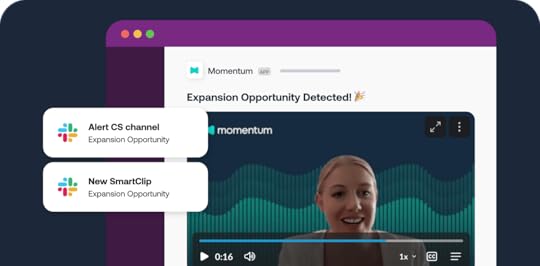 AI GTM - a little bit less conversation, a little more action, please!
AI GTM - a little bit less conversation, a little more action, please!Viral LinkedIn posts of how CEOs are bragging about how they’ve fired 50-90% of their sales, marketing, and support departments and replaced them with AI…
Vs.
“FUD - Fear, Uncertainty, Doubt.” Studies have shown that 95% of AI pilots fail.
Vs.
Consulting firms reporting that 78% of companies are advanced AI users (and selling their transformation services to others).

How to make sense out of all these contradictory statements that are popping out faster than ever? You and I probably agree that AI is here to stay, but my personal experience in GTM is that there is a lot of talk about it, and usually very little to show. And I don’t seem to be the only one thinking so.
Momentum, an AI RevOps orchestration platform, analyzed over 1,000 calls from their prospects (SMBs and enterprises alike) in the last 6 months across 150+ industries. Remember - those companies are EARLY adopters of enterprise AI, not some dinosaurs that are only now catching up with cloud computing. Based on analysis of actual sales conversations (not self-evaluation surveys where everybody wants to look cool), they concluded that:
60% of companies are still doing lots of manual work that could be done with mainstream AI (lagging in adoption of AI based on what technology can do ATM),
29% have started to use AI, but as fragmented projects,
Only 11% have advanced, orchestrated AI implementations that support end-to-end workflows, enabling AI agents to utilize artificial intelligence for decision-making.
More insights from Momentum’s survey on how companies are adopting AI in 2025 will be available in their next report - I’ll share it in GTM Strategist as well.
Fun fact: these days, the final stage is called agentic AI agents :) - because the term AI agents is often used to describe standard automations that can be achieved with tools like Zapier at significantly lower cost - essentially, people building agents for the sake of building agents 🤷 oh, well.
And yeah - that made us think that 90% of AI adoption is fiction.

So if you feel like you’re behind, you kind of are based on what technology can do ATM.
But good news - so is almost everyone else 😅, so let’s catch up really fast.
The challenge isn’t adopting “any AI.”
The challenge lies in adopting AI that delivers tangible benefits and positive ROI to your business.
And I believe the best place to start is by re-visioning workflows in validated GTM Motions (predictable and scalable ways to get customers).
Kyle and I need YOUR Input: GTM Motions & AI adoption - Where are we really at?By now, I do not know a single working person who does not use AI.
Last week, OpenAI & Harvard researchers published a massive study that beautifully illustrated what Ruben Hassid has brilliantly described as
The Big Three use cases of ChatGPT (≈80% of all chats):
Practical Guidance (how-to, tutoring, creative ideation)
Seeking Information (search-like queries)
Writing (drafting + editing).
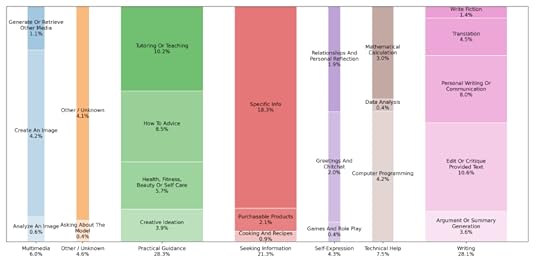 Why people are using ChatGPT https://www.nber.org/system/files/working_papers/w34255/w34255.pdf
Why people are using ChatGPT https://www.nber.org/system/files/working_papers/w34255/w34255.pdfEven my 60-year-old mother, who works as a student manager at a university, uses ChatGPT. When she got a new phone, one of the first apps she wanted to transfer was “artificial intelligence,” aka ChatGPT. At that moment, it became crystal clear to me that we have reached an early majority.
As ChatGPT/Claude/your favorite AI model becomes a modern-day browser, personal assistant, confidant, document management system, and editor/proofreader, we have to tackle AI-empowerment of GTM motions a bit differently.
By now, every GTM motion has undergone a significant transformation over the last year and a half, incorporating at least some AI-enabled tools, workflows of even opportunities to implement AI agents and multi-agentic workflows.
While it is more likely that you are getting a message from an AI than a human you don’t know in the outbound arena, where practically all the mainstream vendors have adopted at least some AI capacities and companies are testing 1000s of AI generated or assisted ads creative daily, GTM motions include more human components that are changing at a slightly slower pace - but they are changing.
But I might live in my special AI-loving-bubble 🫧 here, and to be able to serve you more accurately insights into the future - I need your help!
Kyle Poyar and I joined forces to work together on the GTM Motions 2025 Survey.
We are aiming to collect >2000 responses that will get us great insights on:
What is changing and what is not changing in GTM with AI
What is working and what is not
What are the top tools
How are 2026 GTM prospects looking globally?

Please fill in our survey here
So we can prepare a holistic, well-researched report on the topic.
We REALLY need you in our corner for this, so please feel free to share the link to the survey on your social media, newsletters, or directly with your colleagues and other GTM practitioners who are crafting the future of AI GTM.
Huge thanks, friends 🙏
Implementing AI to GTM Motions? Think Workflow first.One of the first GTM motions that I’ve strategically wanted to elevate with AI was Inbound.
 Schema of my Inbound GTM Motion reinvented to be AI-first
Schema of my Inbound GTM Motion reinvented to be AI-firstWhy? Because we spend 30+hours a week there with the team, and it still accounts for 70+% of our pipeline.
So yeah, instead of playing around with “random tools” and vibe-coding “dog name generators”, I wanted to make a measurable impact on a workflow that is already well established and mature in my business.
This was the process I used for elevating my LinkedIn process:
List all the processes, tools, activities, responsibilities, and time spent there
Identify the bottlenecks - where are we spending most time or marginal impact (candidates for automation)
Study where automations will do the job and where are the strategic opportunities for implementing AI - aka agents in the workflow
Redefine the workflow using opportunities to implement AI
Prioritize implementation opportunities based on effort-impact
Make sure you have good data sources - garbage in, garbage exponentially out when it comes to AI
Sharpen the prompting skills of my team and generate hands-on examples of what “great looks like”
Select the tools and do test implementations - we tested 8 tools to select 3 to include in our ongoing processes
Test in control environments to make sure it works
Tweak, scale and present to clients and partners.
All in all, I use 3 custom AI writing assistants, 4 automation custom scripts, a “team” of 7 AI agents + 5 tools to support this process.
After the implementation, we managed to reduce the time spent on our “content and adjacent work” to 17h/week, and the pipeline got “better”.
I will not throw around random numbers like “This is a 2M ARR workflow run by 7 agents”. This is a process that took years to build and perfect. Now it is supported with AI - but it still takes a significant amount of human input and strategic thinking muscles.
I am blessed to work with some of the best companies in my career and fantastic AI-first startups and scaleups with so much potential. I have never been happier with the type of work I do.
Some agents that we benefit the most from:
Research agents - search for best practices of influencers on LinkedIn to create design moodboards and train AI writers
“ICP fit” agent + social selling ideas - helps us extract selling signals from social media posts, analyzes accounts and plans the best way to start the conversation with them
LinkedIn writing coach - that analyzes my results, benchmarks them against best practices and gives me hands-on recommendations on how to improve
But even the best agent breaks down without clear prompts.
Head of GTM at Momentum and self-identified prompting geek, Jonathan “Coach K” Kvarfordt, teaches the GRACE framework:

G – Goal or Role: What outcome do you want? Who should the AI “be” (finance analyst, McKinsey consultant)?
R – Rules: Clear rules and boundaries.
A – Advanced Context: What’s happening in your system/business? The more background context, the better.
C – Clear Instructions: Tell AI what you want in a sequence of steps.
E – Examples: Show what “good” looks like (and what “bad” looks like).
I applied it to my work too, and it works like a charm, especially with GPT-5.
Most failures come from missing context or missing examples.
Get those right, and hallucinations drop dramatically. 👌
Uf - running out of space here and so much more to tell and show you …
How about this:
Join Jonathan and me at the Momentum AI Hub webinar on Oct 8th, 2025, at 12:00 EST.
FREE online and we’ll show you how we do it IRL.
 So, where does our “Carbon Intelligence” fit in this AI-first GTM Motion world
So, where does our “Carbon Intelligence” fit in this AI-first GTM Motion worldAs we discuss the changes in GTM, Jeff Bezos suggests we ask ourselves what will remain unchanged.
Every trend has an anti-trend, and here is my best guess of what that might be for AI-enabled-everything in GTM.
As long as humans continue to interact with one another, trust, intimacy, genuine human connections, empathy, and other “softer skills” will inevitably become more valuable.
The other thing that will not change is stakeholder management 🙂 - as long as humans work with humans, this skill will become more valuable than ever. I like to joke with my teams - no AI is smart or stupid enough to replace stakeholder management.
Last but not least - we humans are the architects of AI workflows and implementations, so even if we enter the “future” where my buying agent will transact with your seller agent without us ever meeting, these agents would be trained on our knowledge assets, so in a way, they would be partially like us.
To keep these conversations more hands-on - utilize AI for what it is excellent at - double down on strategically bridging the gaps where it fails and on what it was not designed to do by default.
As Ben Williams (PLGeek), put it in The New Growth PM Playbook: What AI Can’t Replace:
“AI excels at pattern recognition, synthesis, and suggestion—it can clean data, draft onboarding copy, cluster feedback, and generate test ideas faster than humans ever could. But defining the right problems, making strategic trade-offs, and building trust across teams remain deeply human responsibilities. The edge for growth leaders in an AI-first GTM world is not competing with AI on execution, but doubling down on judgment, influence, storytelling, and empathy. In other words: let AI automate the busywork, so you can focus on the higher-order skills that move markets and build trust.”
But most importantly - run towards your fears.
Learn it. Prototype with it. See if it can help you.
Who knows - maybe you will end up finding a lot of value and have fun with it.
But keep your critical thinking and security awareness intact.
My rule of thumb is: if I wouldn’t send a file to a friend, I won’t upload it to ChatGPT.
What is yours?

📘 New to GTM? Learn fundamentals. Get my best-selling GTM Strategist book that helped 9,500+ companies to go to market with confidence - frameworks and online course included.
✅ Need ready-to-use GTM assets and AI prompts? Get the 100-Step GTM Checklist with proven website templates, sales decks, landing pages, outbound sequences, LinkedIn post frameworks, email sequences, and 20+ workshops you can immediately run with your team.
🏅 Are you in charge of GTM and responsible for leading others? Grab the GTM Masterclass (6 hours of training, end-to-end GTM explained on examples, guided workshops) to get your team up and running in no time.
🤝 Want to work together? ⏩ Check out the options and let me know how we can join forces.
September 19, 2025
What Companies Are Doing TODAY to Rank High on AI Engines
Dear GTM Strategist!
After the unexpected success of the first Generative Engine Optimization (GEO) article that instantly became one of the most popular posts here in 2025, I wanted to double down on what you are apparently interested in.
While we are still figuring out how to call the new SEO in the age of AI…
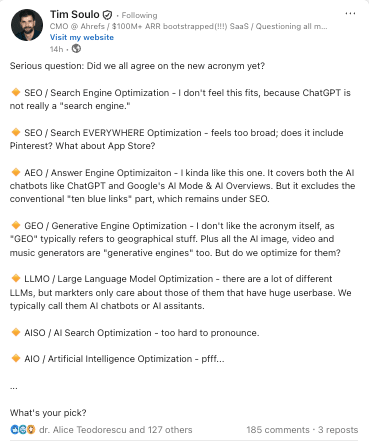 https://www.linkedin.com/posts/timsoulo_serious-question-did-we-all-agree-on-the-activity-7371958218161344512-gpvR
https://www.linkedin.com/posts/timsoulo_serious-question-did-we-all-agree-on-the-activity-7371958218161344512-gpvR…some champs in my network managed to unlock a massive new revenue opportunity by being one of the first hits for AI searches in their category.
Today, I share some of their GEO playbooks with you, and I prepared a checklist on how you can elevate your GTM traction and become one of the first companies to unlock this massive opportunity to become “go-to” entities in the era of zero-click customer journeys.
You’ll learn:
How to analyze your brand and how well or poorly competitors are doing on AI engines using Brand Radar 2.0 by Ahrefs
3 case studies of how some AI agent tools became leaders in their category
I’ll share my checklist for GEO optimizations that I use with my clients
This time, no “what is GEO” - fundamentals are well covered here. This time action only, so let’s get tactical! ✌️
Understand the space you compete in: Brand RadarEvery great GTM playbook begins by observing what works well for others, generating intelligence, and then acting based on that insight.
GEO used to be a black box, but new tools are now increasingly enabling visibility into how the answers are shaped in ChatGPT, Google AI Summaries, and other AI chatbots.
I analyzed some of the top AI agents brands in my space to determine which ones index well for GEO, allowing me to reverse-engineer their best practices.
Here is a tl;dr version:

Next, I wanted to dive deeper - what exactly are these companies doing so right?
How did they crush the AI ranks - often against all odds, since some of them are not category leaders and are competing with billion-dollar competitors with massive content, SEO and search budget 🤷
I wanted to learn exactly what they did and how you and I can replicate their success.
How AI search really differs from traditional searchThe biggest mistake I see right now?
Founders assuming their SEO strategy will “just carry over” into AI search.
It won’t.
Here’s why the new rules of the game are so different:
From clicks → to citations
Traditional search engines give you a buffet of links. The game is to win clicks and position as high as possible.
In AI search, there are no blue links to compete for - the prize is to be mentioned directly in the answer. A link is sometimes just a bonus.
From websites → to answers
SEO’s mission has always been: “bring traffic to your website.”
GEO flips that: even if users never land on your domain, you still need to be accurately represented inside the AI-generated answer itself. Yes, due to AI search, website traffic is already falling. Many companies report higher conversion rates from AI traffic - customers arrive at your website better informed, later in their buying journey, because they already did their research elsewhere (in their AI chatbot). That’s why you need to be visible in AI search.
From backlinks → to trust signals everywhere
Google rewards backlinks and domain rank.
AI engines reward breadth and credibility across multiple trusted and credible sources: try to get mentioned on review sites, “best of” lists, community forums like Reddit, expert commentary, and even mentions on social media like LinkedIn. Here is Ahrefs’ analysis of visibility factors.
From short queries → to conversations
On Google, people type 3-4 words.
With ChatGPT or Gemini, users write long, natural-language questions: “What’s the best project management tool for startups under $50/month?”
That shift changes which brands surface - and who gets left invisible.
From index → to synthesis
SEO is about climbing higher in the index of ranked pages.
GEO is about being consistently present in the summaries AI models generate by blending their training data with real-time retrieval (RAG).
SEO was about being discoverable in a list.
GEO is about being the trusted reference inside a single authoritative-sounding answer.
I used Ahrefs Brand Radar 2.0 to research which companies are rocking GEO in their categories and what they are doing.
It’s very simple to use: you enter your brand and your key competitors (example below - it can even suggest more competitors). Market or niche is optional and I prefer to keep a broader research.
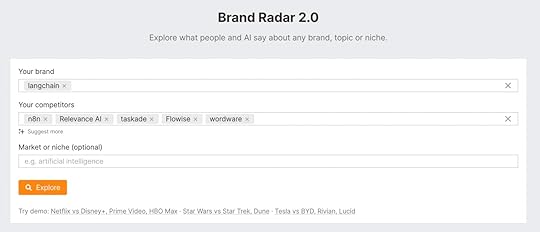 Example of a Brand Radar query
Example of a Brand Radar query
 And this is how the output looks like (we’ll dive into details in a sec)Case 1: AI Agent Builders
And this is how the output looks like (we’ll dive into details in a sec)Case 1: AI Agent Builders

I compared the key players in the field of AI agent builders and I see that LangChain’s AI mentions really skyrocketed from August on.
One of the key resources cited by LLMs is an AWS article that explains what LangChain is. This shows that mentions (well, not just mentions, but deep dive articles) on high authority websites can really move the needle in GEO.
But even n8n, although with more modest growth, can be reverse-engineered to some good practices with Brand Radar. They hold a solid 2nd place in the category, and one of the top-cited resources is a debate in the “Automation” subreddit on Reddit.
Here is how the top-cited domains in GEO for AI agent builders look like:
 Case 2: AI Sales Agents
Case 2: AI Sales Agents

For AI sales agents, Momentum.io is leading the game. In this case, Brand Radar data just confirmed what I was already hearing before from the team: they doubled down on their inbound strategy in the last months and started generating lots of blog posts on different topics connected to actual questions that customers would ask AI chatbots.
These questions differ from googling. Whereas on Google a user would mostly write keywords (e.g. best AI sales tools), on a chatbot, a user would write a specific problem-related question, like: “How can I improve the productivity of my sales team?”
The result: blog posts like this one that are often picked up by LLMs:

Looking at the top-cited domains, we see once again how general high-authority websites like YouTube are driving the mentions, too.
Case 3: AI Marketing Agents
Well, you can be sure that it is a marketing category because there are more competitors trying hard, each with its own good practices.
Copy.ai leads the pack, although Rytr actually has the top-cited page:

A variety of sources still trumps a single well-positioned source.
The mentions are quite consistent across the chatbots:

This means that strategies for optimization are similar.
And as you can see, although we are used to thinking of AI search as ChatGPT, Google is stepping up the game with its AI Overviews, so the majority of AI search is already being transferred to Google.
And this is another case in point that you need to think beyond traditional SEO: because Google itself is drastically changing the way it delivers answers to queries and is shifting to the zero-click strategy as well.
(We’re all still curious how it will impact their Google Ads business model.)
Meanwhile, these are the topics that AI marketing agents are being mentioned on:

Wow! That was interesting.
Now, based on my independent research with Brand Radar, best practices from my colleagues in the network and AI search engine algo studies by Ahrefs - I can give you a long story short version of this research process.
Here is my GEO checklist of what you need to do to get your brand indexed on GEO based on insights that we have in September 2025 for those that might be reading later.
GEO Checklist: What Brands Need to Do to WinIf SEO was about optimizing pages for web crawlers, GEO is about optimizing your entire digital footprint for AI answers.
Here’s the checklist I now use with my clients:
Audit your presence inside AI engines
Run prompt tests in ChatGPT, Gemini, Perplexity, Claude. Track: Is your brand mentioned? Which competitors show up? What sources get cited?
Design a set of prompts to regularly test
Don’t just test “best CRM” - mimic real user behavior: “What’s the best CRM for me as a solopreneur?”
Expand beyond your website
AI models pull from community and third-party sources. Secure mentions in “best of” lists, industry reviews, Reddit, trusted media, and ask well-known partners or customers to publish a post about you (remember the AWS example for LangChain).
Upgrade your authority signals
Publish fact-based, up-to-date, structured content. Make docs, tutorials, and case studies crystal clear so LLMs can cite them with confidence.
Accelerate content velocity
Momentum proved this: publishing 100+ high-quality articles in a single month was enough to dominate their category in AI search. Consistency compounds.
Prioritize low-hanging fruit
Follow Ahrefs’ research: there are still queries with low competition where early movers can claim visibility fast. Don’t start with the hardest prompts.
Track, iterate, repeat
GEO is not “set and forget.” Signals shift faster than Google’s algorithm ever did. Re-run your benchmarks monthly, close visibility gaps, and expand coverage.

Winning GEO isn’t about tricking algorithms.
It’s about becoming so visible, credible, and frequently cited that AI engines can’t ignore you.
How to put GEO in practice: your 7-day and 6-month plansWinning GEO isn’t a one-off campaign.
Here’s an implementation plan you can follow:
In the next 7 days (audit and quick wins)
Run your first benchmark: Test prompts in ChatGPT, Gemini, Perplexity, Claude to check how you score.
Audit your Brand Radar score in Ahrefs (visibility of your brand vs. competitors).
Build a set of prompts - 10–15 queries that include real buyer questions (“What is the best tool for [task]”, What are the best alternatives to [category leader]”...).
Identify your biggest gaps: Which competitors are visible where you’re invisible?
In the next 30 days (building the foundations)
Refresh or publish core content designed to be easily cited: FAQs, tutorials, comparisons, case studies.
Place your brand in third-party ecosystems: “best of” lists, review platforms, forums, expert mentions on social media…
Start building backlinks with context: Guest posts, partnerships, social campaigns that tie back to your category keywords.
Create a visibility tracker: Spreadsheet or Notion board logging prompts, engines, mentions, sources, and competitors.
In the next 3 months (getting the momentum)
Scale your content velocity: At least 2–3 high-quality, relevant pieces per week.
Run monthly benchmarking across your set of prompts to measure improvement.
Analyze citation sources: Which blogs, docs, or community mentions get your competitors cited? Reverse-engineer and replicate.
Experiment with structured content (schemas, metadata, clear headings) to increase LLM interpretability. LLMs work best when content follows structure.
In 6–12 months (durability)
Aim for ecosystem integration: being recommended in educational resources, industry reports, curated libraries, try to secure a mention in high-authority media, or by well-known partners.
Establish canonical authority: whitepapers, industry benchmarks, research-backed content that LLMs will pick up on in the next retraining cycles.
Layer on advanced distribution to target international audience: translations, localization, multimedia content that strengthens your long-term presence across global LLMs.
Your Weekly GEO WorkflowTo stay on top of GEO without burning out, set yourself a reminder to focus on a few small high-impact tasks every week:
Benchmark visibility → Run a quick Brand Radar check + test 2–3 prompts from your set. Check who’s surfacing in AI answers where you’re not and log insights.
Publish or update content → Ship at least one asset (FAQ, tutorial, comparison, case study).
Secure one new mention → Pitch for inclusion in a “best of” list, guest post, or community roundup.
Engage in communities → Answer 2–3 relevant questions on LinkedIn, Reddit, Quora, Stack Overflow, or niche forums.
If you keep this rhythm, your GEO presence compounds week after week.
GEO is still a new field and as you could see, the rankings can change fast. Luckily, this means that we are have a similar starting point with the right strategy.
So just start, explore, experiment, monitor, and let me know what works for you.
Let’s go to the GEO market!

📘 New to GTM? Learn fundamentals. Get my best-selling GTM Strategist book that helped 9,500+ companies to go to market with confidence - frameworks and online course included.
✅ Need ready-to-use GTM assets and AI prompts? Get the 100-Step GTM Checklist with proven website templates, sales decks, landing pages, outbound sequences, LinkedIn post frameworks, email sequences, and 20+ workshops you can immediately run with your team.
🏅 Are you in charge of GTM and responsible for leading others? Grab the GTM Masterclass (6 hours of training, end-to-end GTM explained on examples, guided workshops) to get your team up and running in no time.
🤝 Want to work together? ⏩ Check out the options and let me know how we can join forces.
September 12, 2025
GTM in the Age of Signals
Inbound is losing its edge.
Outbound is evolving fast.
And the next era of GTM will be defined by how well you read the intelligence.
In this article, you’ll learn:
Why inbound is becoming harder
How signals transform outbound from “spray and pray” to precision GTM.
The types of pre- and post-sales signals you can act on today (free table inside!)
A step-by-step playbook to start using signals in your own outbound.
The bigger ecosystem vision for building a signal-driven GTM Intelligence.

This newsletter is sponsored by ZoomInfo.
Think you know ZoomInfo? It’s no longer just a contact database.
ZoomInfo has rebuilt itself into a full Go-to-Market Intelligence Platform — one that doesn’t just give you data, but actually executes on it.
Signals come in, outreach goes out, and pipeline moves automatically.
The Shift in GTMInbound isn’t dead.
But it’s getting harder by the day.
We’ve entered the era of AI-generated everything. The internet is drowning in mediocre content - blog posts, LinkedIn updates, SEO articles, even eBooks. What used to be a reliable way to pull in leads is now a fight against noise.
On the other hand, the SEO shift is real. You probably already saw what happened to HubSpot’s organic traffic:

You simply cannot expect the same traffic on your website anymore.
The buying journey is moving to LLMs, which are gaining an increasing share of traffic.
How to position for the zero-click reality? It’s still a black box (although this article can help).
That doesn’t mean inbound is irrelevant. It just means the easy wins are gone.
So where’s the edge?
It’s in outbound - but not the outbound you’re picturing.
Outbound - don’t spray and pray. Ecosystem visionSay “outbound” and most people think of spray-and-pray.
Mass email blasts.
Cold calls to random lists.
0.3% reply rates that burn out reps and budgets.
That outbound deserved its bad reputation.
But here’s what most founders and GTM teams are missing: outbound today doesn’t look like it did 5 years ago.
Outbound has become intelligent.
Powered by signals.
Guided by GTM Intelligence.
We’re no longer guessing who might be a fit. We’re watching the market in real time and moving when buyers show intent.
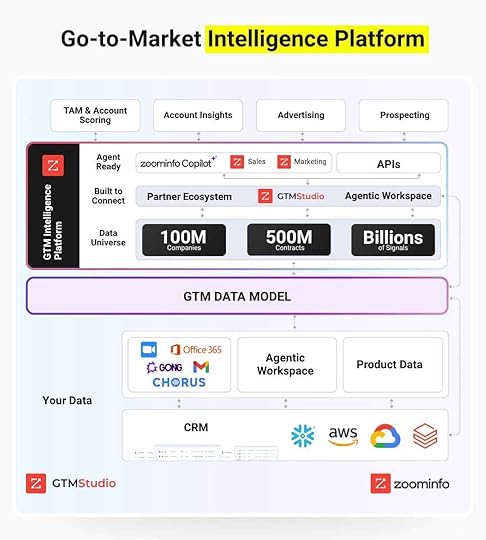 Billions of signals already power GTM IntelligenceWhat are signals (and why they matter now)
Billions of signals already power GTM IntelligenceWhat are signals (and why they matter now)Signals are the clues buyers leave in the market that tell you who is ready, when, and why.
Think about it:
A funding announcement.
A surge in job postings.
A new leadership hire.
A product launch.
A spike in intent data searches.
These aren’t random data points. They’re buying signals.
And here’s the key: signals let you flip the script. Instead of waiting for someone to stumble across your inbound content in an increasingly crowded Google search, you can move first.
You see the signal → you act → you reach out at the exact moment when it matters most.
How Signals Turn Outbound into the Fastest Way to Validate GTMSignals transform outbound from noise to relevance.
Relevance: You’re not sending a generic pitch. You’re reaching out because a company just raised $10M and is hiring 20 SDRs. Your timing isn’t random — it’s aligned with their reality.
Personalization: Your outreach references their context, not your boilerplate. It feels like you’ve done deep research, even when technology does the heavy lifting.
Efficiency: Instead of 1,000 cold emails for 3 replies, you can get meaningful conversations from 50 targeted outreaches.
Scalable precision: With AI + platforms like ZoomInfo surfacing signals in real time, this level of precision is no longer manual — it’s automated, repeatable, and scalable.
Outbound used to be about interrupting.
Nobody likes to be sold to - except when they are already on the market.
Today, it’s about showing up when buyers are already moving.
ZoomInfo recently published an article on this very shift: inbound demand is declining, but outbound is becoming far more effective thanks to signals.
Here’s the core message:
“The most successful teams aren’t waiting for leads to trickle in. They’re using signals to know exactly who to target, when to engage, and how to tailor their message.”
That’s the playbook. Outbound isn’t about blasting. It’s about listening to the market, detecting movement, and acting with precision.
Mini case: Intelligent outbound in actionLet me give you a real scenario.
A founder I worked with noticed a signal: a mid-market SaaS company had just closed a $12M Series A. Within days, he reached out - not with a generic cold email, but with a tailored message about how his product could help their sales team scale faster.
That single signal turned into a warm conversation → a pilot → and within 3 months, a multi-year contract.
This isn’t luck. It’s what happens when you combine signal intelligence with sharp GTM execution.

By the rule of thumb, only 3% of potential customers are ready to buy immediately, and a bit more are actively considering. By focusing on these ones, you optimize your marketing efforts - and budgets.
Here is my recent example.
I narrowed down my very specific offer to only 7 founders of AI SaaS who recently got the investment.
Step 1: Start with the ICP
ICP, or Ideal Customer Profile, is still the way to go. Without clarity here, even the best signals won’t help - you’ll just be chasing noise.
Start with the firmographics:
Industry – Which verticals get the most value from your solution?
Location – Are you targeting globally, or is there a key geography where adoption is faster?
Size – Define both by number of employees and by revenue. A 50-person SaaS startup and a 5,000-person enterprise both buy software, but with completely different cycles.
Then, go deeper:
Technographics – What tools do they already use? Who do they integrate with? Are they on a competitor’s stack you can replace?
Stage – Seed, Series A, or pre-IPO? Each stage comes with different pains and buying power.
Go-to-Market motion – Are they PLG, sales-led, channel-first? The way they acquire customers will influence how they buy from you.
Your ICP is your first filter. It narrows the universe of companies down to the ones where signals actually matter.
When you know your ICP, you can ignore 95% of the noise in the market and focus only on the companies that have the potential to become your best customers.
Step 2: Define your buying committee
Now that you know what type of companies to target - who is the person on the other side? Who do you need to contact?
It might be that several profiles are involved in the decision-making committee or group. One from marketing, one from IT, one from the financials department… The larger the company, the more complex the buying committee can be, and every member will be interested in another aspect of your solution.
Step 3: Mix in the signals
Here is where the signals come in. How to go from a large list to those 3-7% that could be on the market for your solution?
Here are some examples of pre-sales signals from ZoomInfo’s intelligence:
Internal moves: Personnel changes create great prospecting opportunities. For example, when an executive is promoted internally, they typically look to make their mark in the first 90 days, including evaluating existing technology and services and buying new ones.
Competitive tech uninstall: A competitor's customers can be a great source of new business - if you can get plugged into the right signals. Companies that churn from your competitors are already educated on your value proposition and understand its potential. This makes them well-positioned to find a better solution - you.
Website visit: If someone was on your website, it’s possible that they already researched you or that they are at least familiar with your name. In that case, cold outreach won’t really be cold.
Funding round: When a company receives a round of funding, it’s a strong signal that they are likely to begin making new investments to grow their business. It’s an event worthy of congratulations and a natural conversation starter.
Podcast mention: If your prospects were mentioned in a podcast discussing topics relevant to your business, you can leverage this timely and relevant information to initiate engagement, referencing the podcast content and offering a tailored solution that addresses their discussed needs or concerns. Strike while the iron is hot.
However, post-sales signals are just as important for growing revenue and ensuring customer retention.
Upcoming renewals: Don't be caught by surprise when it comes to renewal time. Schedule a customer check-in 90 days prior to the renewal of an existing contract to understand how their priorities may have evolved over the course of the contract.
Low Adoption Engagement: There’s a downsell risk when customers aren’t using the full scope of the product they purchased. Take a look at what each customer is paying for and pinpoint features that are underutilized or not used at all.
Step 4: Orchestrate the campaign
Adapt the messages with personalization and context. Signals are excellent for this stage as well, they provide the rich data for the context.
See it in action - how I found 7 founders of AI companies in the USA who got $3-5M funding in the last 3 months in <4min:
Ecosystem vision: The age of signalsHere is how Millie Beetham, VP of GTM Strategy and ZI Labs at ZoomInfo, describes the role of signals in GTM:
“There is a wealth of data and signals to tap into today. With insights about the businesses you want to sell to—either available out of the box or generated via AI GTM tools like ZoomInfo—there’s a huge opportunity to build an always-on outbound revenue engine. That said, running outdated playbooks that don’t leverage nuanced intelligence about a business and its needs won’t work. You have to get creative with the intelligence you use to nail timing, targeting, and content, or you’ll end up lost in the noise of your target customer’s inbox.”
We’ve entered the age of signals.
Inbound will remain part of every healthy GTM mix. But if even giants like HubSpot are seeing their inbound results erode under the weight of AI-generated content, then founders and GTM leaders need to expand their playbooks.
Outbound is no longer a blunt instrument. It’s becoming the sharpest tool in the box — as long as you use signals to guide it.
The real power comes when you don’t just act on signals once in a while, but when you engineer your entire ecosystem around them.
That means:
Data sources: Funding rounds, hiring patterns, intent data, product launches, tech stack signals.
Tools: Platforms like ZoomInfo, Clay, 6sense, Apollo, LinkedIn Sales Navigator.
Workflows: Automated alerts, AI-assisted prospecting, playbooks that trigger tailored outreach.
People: Teams trained not to pitch blindly, but to translate signals into value-driven conversations.
In this ecosystem, every signal becomes an opportunity — and your team becomes the first to show up when buyers are ready.
ZoomInfo recently published a free table of the best pre-sales and post-sales signals, along with playbooks and email templates. Grab it here.
 How to start with signals
How to start with signalsIf you’re new to outbound, don’t overcomplicate it. Start simple:
Pick 2–3 high-impact signals for your ICP (e.g., funding rounds, job postings, leadership changes).
Build a weekly routine to review these signals in your GTM Intelligence platform.
Create one tailored outbound play for each signal type.
Measure results, refine, then expand your signal set.
Outbound intelligence isn’t built overnight. It compounds. The sooner you start, the sooner you’ll outpace competitors who are still stuck in generic outreach.
The GTM edge no longer belongs to whoever creates the most content.
It belongs to whoever reads the signals best.

📘 New to GTM? Learn fundamentals. Get my best-selling GTM Strategist book that helped 9,500+ companies to go to market with confidence - frameworks and online course included.
✅ Need ready-to-use GTM assets and AI prompts? Get the 100-Step GTM Checklist with proven website templates, sales decks, landing pages, outbound sequences, LinkedIn post frameworks, email sequences, and 20+ workshops you can immediately run with your team.
🏅 Are you in charge of GTM and responsible for leading others? Grab the GTM Masterclass (6 hours of training, end-to-end GTM explained on examples, guided workshops) to get your team up and running in no time.
🤝 Want to work together? ⏩ Check out the options and let me know how we can join forces.
September 5, 2025
5 Pillars of Successful Influencer Marketing Campaigns
Dear GTM Strategist!
As the teams that I am working with search for new ways to launch and scale their products, influencer campaigns often pop up as an “interesting idea”.
It is one of the more effective GTM actions for getting strong traction fast - especially if you are launching, for B2B and B2C alike. Influencers, in combination with some advertising budget to fuel the reach, could be enough to help you validate a new market.
 Influencers are usually one of the first GTM actions companies try.
Influencers are usually one of the first GTM actions companies try.68% of B2B marketers say influencer marketing drives higher-quality leads than any other paid channel (Demand Gen Report, 2024).
While “go where the audience is” and “leverage trust the creators have” makes a whole lot of sense, many companies in my network complain that it is hard to “make it work” and even harder to scale.
Before you go ahead and email 35 YouTubers that have reviewed your competitor that you want a demo too, spend a couple of minutes crafting the influencer marketing strategy to make sure you join forces with the right creators and actually create a ROI-positive campaign.
In this post, you’ll get:
5 best influencer collaboration practices based on my 30+ collabs - what do most successful companies do differently and how you can apply that too.
My Integrated Influencer Campaign Planner - a free tool that will help you define the objectives, streamline the process, and track the performance.
My predictions 🔮 on why this GTM tactic will be alive and well in years to come, and what formats do I recommend you to test when you’re working with influencers.
I initially developed this framework for a client who was kicking off their first influencer marketing campaign. Then I published it to Miroverse as a free board, so it can help more teams.
If that sounds like a good use of your time,
Let’s rock and roll 🤘

This newsletter is sponsored by La Growth Machine.
Are you tired of LinkedIn outreach that gets ignored? Try sending voice messages instead. 🎤
They feel personal and consistently drive up to 2x more replies. And the best-kept secret: they can be automated.
To make it easy for you, La Growth Machine prepared a free resource: 11 LinkedIn Voice Message Scripts with 25% reply rates - complete with best practices on tone and delivery.
 The question I hate: “Maja - are you an influencer?”
The question I hate: “Maja - are you an influencer?”No, I do not identify as an influencer- but funnily enough, I’ve been on all sites of influencer campaigns:
I’ve created content with brands
I negotiated influencer deals with clients
I paid for influencers and worked with them
Had to calculate ROIs of these campaigns and budget for them
Even advised 3 influencer marketing tools on how to go to market 🤷
So yeah, I’d say that I have a pretty good understanding of what is going on in the arena. Over the last two years, I have collaborated with more than 30 brands, creating some fantastic content together. With many, we have become close and are developing long-term collaborations, often meeting personally and outside the scope of our commercial projects.
 Some of my influencer engagements. I love doing product demos.
Some of my influencer engagements. I love doing product demos.While working with founders, CMOs, influencers, managers, and their agencies, I learned five lessons that most successful companies do differently and diligently.
The first thing we discuss at every meeting is the ICP-fit and their goals. We will compare data - not “we think that we have a good match”.
They all provide extremely detailed briefs and offer demos, onboarding, and product access, so I can really understand their products. I test all of the products I recommend on my business or clients - this is a non-negotiable for me. And I think it should be for everybody working in the B2B space.
We co-create content plans and content together, and they will always appreciate my recommendations of what would work best for them since they trust that creators know the audience best. I get fantastic assets from them and access to their world-class talent that would probably never respond my “hey - wanna do a Substack together” pitch.
Most successful brands think beyond one-time collaborations. They do not see creators as “billboards”; they are searching for brand ambassadors who co-create content with them and are power users of the product, attending events. We create very meaningful relationships.
They care so much. They typically assign at least one of their team members to be there for creators. They are not relying on agencies to “just get the job done” instead of them. They work closely with their agencies and creators to align multiple collaborators that they work with. Most brands I work with have 10-30 ongoing influencer collaborations - some have hundreds.
I’ve also seen some horrible business practices that I’d never recommend you use.
Avoid these mistakes:
💥 Outsourcing EVERYTHING to an agency or a freelancer who “does the job of getting you those 5 posts you want within your budget” without even understanding your product and ICP.
💥 Working with money-grabbing shitfluencers who will publish anything without the slightest concern what partners will get out of a collaboration - yup those “I open your website and take a selfie” people.
💥 Send detailed scripts to influencers to read your media message and post it to socials - you can just use AI for that (ElevenLabs has some pretty sweet avatars #notsponsored), it will probably be more authentic.
💥 Influencers not responding to messages and delaying their posts or simply disappearing when they should post.
💥 Brands being so slow and annoying/reviewing in and approving the materials that the whole enthusiasm of working together fades … or extends the collaboration to 2 months instead of weeks.
Ufff - rant over 🧘, sorry, but this stuff really makes me mad because I think influencer marketing is an excellent channel that works well, and I do want to contribute to its good name. Now - let’s craft your Influencer campaign together.
⚒️ FREE Tool: Integrated Influencer Campaign PlannerI initially created this framework for one of my B2B high-tech consulting clients that is launching their first YouTube and LinkedIn campaign, but it could help many more teams, so I asked for their permission to publish it in Miroverse so you can take it for a spin too.
Inside, you’ll find:
✓ Strategic planning section
✓ Influencer fit criteria
✓ Outreach scripts
✓ Campaign tracker
✓ Reporting dashboard layout
I hope you will enjoy this playbook.
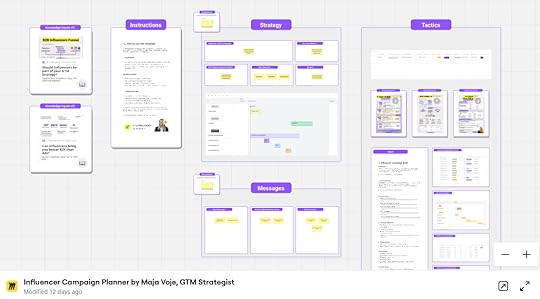
But before you hop right in, I have a couple of sidenotes just for you:
Tools for influencer selection are less relevant than if you just ask your audience who is the influencer you trust/get the best idea from. Getting new followers with viral posts and participating in engagement pods does not make someone influential. The only thing that matters is if they are or could appear to be trustworthy to your ICP. Filter everything through that lens.
The influencers campaign brief I share in the framework is a ChatGPT-generated summary of some of the best briefs that I have received as an influencer - I put 10+ examples of good briefings there and anonymised it.
The tables are derived from real sheets that we use to track $20,000+ influencer campaigns
In the template, you will also find recommended pricing for different levels of influencers (nano, micro, macro, mega)
There are messaging examples and event tips on how to get some free coverage, if you’ll explore the articles in the template.
How big should your creators be — and what should you pay?Start by choosing the collaboration format: a simple shout-out/post (lower cost) or higher-engagement formats like webinars, live demos, and co-created assets.
Follower count isn’t the main criterion - ICP fit is. Always request an audience breakdown (reach and geography), review engagement quality on sponsored posts, and ask for outcomes from past promotions. I’ve seen niche “nano” creators with a few thousand followers generate real pipeline while 100K+ generalists fall flat.
Here are some ballpark figures and characteristics for different sizes of influencers:

And since 2025 seems to be the year of “everything is dead” “nothing works,” and “AI will take all jobs” echoing - let me wrap this one by sharing some closing remarks on why I think Influencer marketing will work well in 2026 and beyond.
🔮 Why I am bullish on influencer marketing as a GTM Tactic in 2026 and beyondInfluencer marketing has always been and will continue to be about trust and credibility.
When I bought a house in a village and moved there, I needed a new hairdresser.
I asked my aunt and neighbor for recommendations.
For the last three years I have been going there.
They were my influencers.
Now apply the same logic to a 50-100K audience.
A creator has spent years nurturing content, interactions, and free value.
(For those who might be interested, that is a workload of 10-40 hours a week.)
Many of my friends work in e-commerce advertising.
2-5 years ago they were recruiting influencers like crazy, pouring Meta budgets into using their posts in their advertising campaigns.
Their initial reach mattered less than how their ads performed with their creatives.
Many of those influencers have been successfully replaced with AI in the last 2 years.
Before: Coordinate with everybody, send them materials, and approve creatives
Now: Develop a couple of proven prompts and test 1000s of creatives at the same time to perfect them.
Typically I’d joke that whatever happens in performance marketing e-commerce comes with 3-5 years delay to B2B. Not this time.
Buying a $100,000/year software contract is different from buying a body shaper from Instagram ads.
The buyer journey, the level of trust, onboarding, and the evidence required, as well as the financial consequences of taking the wrong decision… the stakes are high.
No, AI-generated videos and fake LinkedIn profiles with artificially grown 100K+ audiences will not replace B2B influencers with deep expertise in complaints and strong communities anytime soon.
My prediction actually is that trusted brand ambassadors and marketing partners will become more important in the world of AI-deep fakes, where trust is violated on every scroll.
Feel free to challenge my assumption in comments; I love to exchange views.
Here are some of the collaborations I am planning in Q4:
For the third time in a row, I was invited to speak at Product Drive by Userpilot <3. The keynote How AI Agents Go to Market (and why it’s nothing like SaaS) is a synthesis of my discoveries working almost exclusively with AI agents for the last year and a half. This year, I am happy to share virtual stage with Elena Verna, Kyle Poyar, Leah Tharin and many other amazing experts. You can register (free, online event) here.
I will join Miro in person in NYC at their mega-event Canvas 25 in October. This year’s event aims to crack the code on AI collaborations. Miro will launch a bunch of exciting features, product updates and use cases that I will gladly share with you later.
Momentum and I will host an AI GTM webinar together (more info soon)
ZoomInfo will share their most comprehensive signals list that helped them become a billion-dollar category leader.
And SO much more …

👏👏👏 to all our partners who help us keep this Substack free, insightful and fun.
Hope you liked this one and found some interesting ideas that you can apply to your business.
If you did - hit me a like on LinkedIn or ♥️ in on Substack so I will know that you find this topic interesting and I can plan more of such content in the future. ✌️

📘 New to GTM? Learn fundamentals. Get my best-selling GTM Strategist book that helped 9,500+ companies to go to market with confidence - frameworks and online course included.
✅ Need ready-to-use GTM assets and AI prompts? Get the 100-Step GTM Checklist with proven website templates, sales decks, landing pages, outbound sequences, LinkedIn post frameworks, email sequences, and 20+ workshops you can immediately run with your team.
🏅 Are you in charge of GTM and responsible for leading others? Grab the GTM Masterclass (6 hours of training, end-to-end GTM explained on examples, guided workshops) to get your team up and running in no time.
🤝 Want to work together? ⏩ Check out the options and let me know how we can join forces.
August 29, 2025
How AI Agents Generate $1.5M+ Pipeline Every Month
Dear GTM Strategist,
Every week, I see people confuse “AI agents” with cheap SDR replacements.
But the reality? The founders winning with AI are building leverage systems, not digital labor.
This week, I’m excited to host Amos Bar-Joseph, CEO of Swan AI, who runs one of the boldest GTM experiments I’ve seen:
Amos generates $1.5M+ pipeline every month, solo, with zero SDRs and marketing budget.
In this post, you will learn:
Why most GTM leaders are thinking about AI agents the wrong way
How to plan for $10M ARR per employee with a super small team
How Amos built 7 AI agents for his personal “intelligence network” (with detailed instructions and prompts)
How Swan AI is redefining what GTM looks like in the autonomous business era
Why the future isn’t about automation, but amplification of human genius
This is a masterclass in what it means to wield AI as leverage, not labor.

This newsletter is sponsored by Momentum - and they just launched Smart Clips.
Stop scrubbing calls. Start sharing what wins.
Turn deal-winning call moments into instant, shareable video highlights
Your best call moments don’t live and die on a single recording. They become reusable assets for coaching, onboarding, competitive intelligence, and deal acceleration without adding more work to anyone’s plate.
How it works for your team:
Finds the signal automatically. No human scrubbing.
Follows your focus. Prompts like “Top SPICED discoveries” or “Best competitive handling” direct the AI.
Delivers where work happens. Slack, Microsoft Teams, and Momentum instantly.
Matches length to value. No one-size-fits-all time limits; every clip is the right length for the content.
Works in real time. Highlights are ready minutes after the meeting ends.

Now, let’s hear it from Amos Bar-Joseph.
The 100x SellerI generate $1.5M+ pipeline every month - alone, zero SDRs, zero marketing budget. AI agents aren't digital labor; they're leverage. Here's how I use them to become a 100x seller.
Most GTM leaders see AI agents as cheap replacements for junior salespeople - digital labor to handle repetitive tasks. That mindset isn’t just outdated; it positions you to lose the AI revolution entirely.
When the playing field is leveled by AI, your only edge becomes your talent stack: your creativity, strategic vision, and deep understanding of your buyers.
The winners won’t be those with the best AI - they’ll be those who best amplify their human edge.
That’s exactly what we’ve built at Swan AI: not a team of digital workers, but an operating system that turns every founder into a 100x version of themselves.
Our mission is simple: hit $10M ARR per employee with a super small team and an army of AI agents - no bloat, no fluff, no fallback plan.
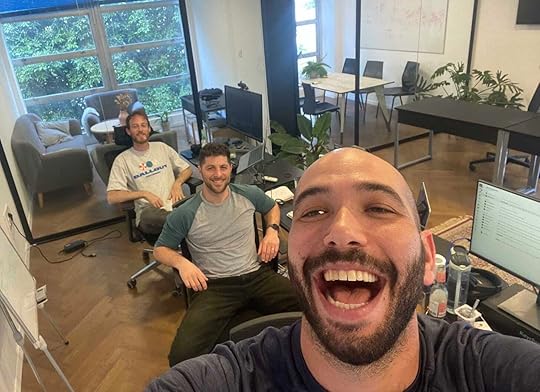 Swan AI: lean team with an army of AI agentsThe Intelligence Network
Swan AI: lean team with an army of AI agentsThe Intelligence NetworkAnd so today I’m the only one doing GTM. But with AI agents behind me, I move like a 20-person growth team - testing, shipping, and closing faster than most GTM orgs.
Last month alone, I generated $300k ARR all by myself.
My secret? I don’t manage a GTM team. I manage an intelligence network designed from the ground up to turn me into the 100x version of myself.
My AI agents are not built to replace me. They are designed around my passions, strengths, and weak spots. And my biggest passion? Storytelling.
More specifically, storytelling on LinkedIn. In less than 5 months, I grew from 2k-30k followers, generated more than 5,000,000 impressions, and endless pipeline. And so my entire army of agents is centered around making this LI game our unfair advantage.
You can think of the following intelligence network as a demand funnel - from writing the posts, to converting the demand, to booking calls and sending follow-ups. My agentic swarm helps ME do it all at the speed of thought so we can scale our revenue with intelligence, not headcount.
Each AI agent in my stack plays a unique role - and together, they compound my impact:
Shakespeare helps me turn raw thoughts into viral LI posts - generating 1M+ impressions a month.
The Observer listens for intent across 10K+ LI reactions and flags warm leads I’d never notice.
The Connector reviews 3K monthly connection requests and opens DMs with the right ones.
The Hunter analyzes 5K+ monthly website visitors who didn’t convert, qualifies them, and helps me engage the hottest ones personally.
The Gatekeeper enriches and filters 1.5K monthly inbounds and routes them to trial, demo, or waitlist.
The Prep Agent builds CRM-ready research briefs for 70 demos/week.
The Listener creates tasks, logs call summaries based on our sales framework, and drafts follow-up emails - so I can move straight to the next deal.
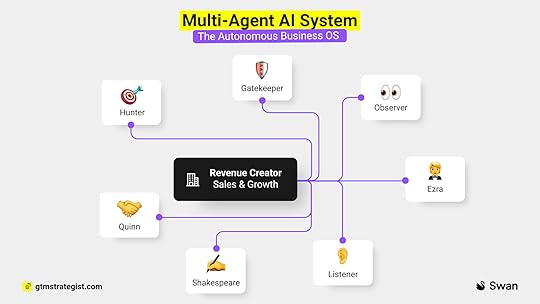 How It Works
How It WorksIt’s not automation.
It’s orchestration.
Each agent feeds the next. And together - they turn one founder into a GTM powerhouse.
The next generation of businesses won’t be run by big teams.
They’ll be run by bold operators who know how to wield AI as leverage - not labor.
Here’s the full guide on how each one of them really works.
The Prep Agent (Ezra)The Prep Agent ensures I'm fully prepared for every sales conversation.
What it does:
Creates comprehensive research briefs for 70+ weekly demos
Gathers company information, recent news, competitive insights, and stakeholder details
Identifies potential pain points and buying triggers based on the prospect's context
Suggests personalized opening questions and talking points
Impact: I enter every call fully prepared, even when back-to-back meetings leave no prep time.
Stack required:
Swan AI - we use our own tool, it’s an AI GTM engineer that can build these agentic workflows for us
Or you can build this with n8n, here’s the link to a step-by-step guide
Sneak Peek:
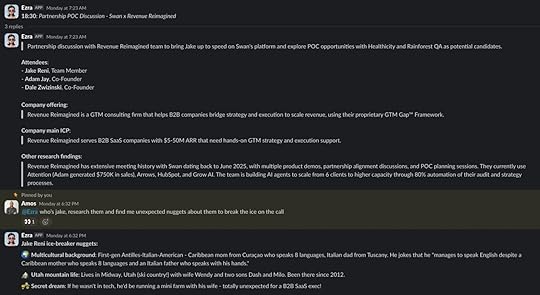 The Observer
The ObserverThe Observer is my LinkedIn intelligence agent, designed to monitor engagement across my content and identify potential leads.
What it does:
Monitors all reactions, comments, and shares on my LinkedIn content
Analyzes engagement patterns to identify people showing consistent interest
Flags warm leads based on their engagement history, job title, and company fit
Creates prioritized lists of people to connect with based on engagement quality
Impact: I never miss potential buyers hiding in my 10K+ monthly engagements.
Stack required:
Unipile - to scrape comments + reactions of a given post URL
Generct - to scrape LinkedIn profiles at scale for qualification
Slack - to notify the relevant person and surface data wherever they already work
Make - to create the agent logic and connect all the apps
Sneak Peek:
 The Connector (Quinn)
The Connector (Quinn)The Connector manages my network growth, focusing on quality over quantity.
What it does:
Reviews all incoming connection requests (3K+ monthly)
Evaluates each person's potential fit based on role, company, and engagement history
Drafts personalized connection acceptance messages for high-potential contacts
Suggests relevant content or questions to start meaningful conversations
Impact: My network grows with qualified prospects while conversations start automatically.
Stack required:
Unipile - to scrape comments + reactions of a given post URL
Generct - to scrape linkedin profiles at scale for qualification
Slack - to notify the relevant person and surface data wherever they already work
N8N - to create the agent logic and connect all the apps
Sneak Peek:
 The Hunter
The HunterThe Hunter helps me find and engage with anonymous website visitors who showed intent but didn't convert.
What it does:
Analyzes 5K+ monthly website visitors using reverse IP lookup and other techniques
Identifies companies and potential decision-makers who spent significant time on key pages
Qualifies leads based on company size, industry, and browsing behavior
Creates outreach plans for the most promising anonymous visitors
Update/create the relevant records within our CRM
Impact: I recover high-intent prospects who would otherwise remain anonymous.
Stack required:
Swan AI - we use our own tool, it’s an AI GTM engineer that can build these agentic workflows for us
Sneak Peek:
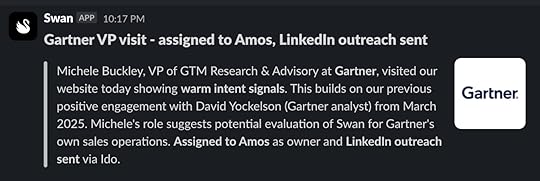 The Gatekeeper
The GatekeeperThe Gatekeeper qualifies and routes inbound interest to optimize my time and conversion rates.
What it does:
Enriches 1.5K monthly inbound requests with online research, and firmographic + technographic data
Applies qualification rules to segment leads into trial, demo, or waitlist paths
Personalizes responses based on lead source, company profile, and stated needs
Manages the entire qualification workflow while flagging VIP opportunities
Updates/creates CRM records accordingly
Impact: Every lead gets a tailored experience while I focus only on qualified opportunities.
Stack required:
Swan AI - we use our own tool, it’s an AI GTM engineer that can build these agentic workflows for us
Sneak Peek:
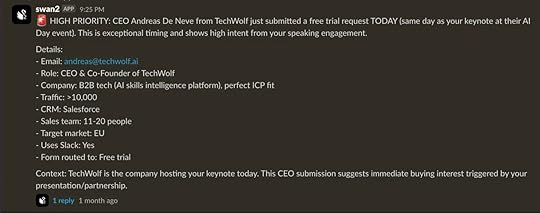 The Listener
The ListenerThe Listener turns every sales conversation into actionable next steps without manual work.
What it does:
Transcribes and analyzes all sales calls using our proprietary sales framework
Extracts key insights, objections, and next steps automatically
Drafts personalized follow-up emails based on conversation highlights
Creates and assigns CRM tasks to keep deals moving forward
Impact: I can move directly from one call to the next while maintaining perfect follow-through.
Stack required:
Circleback - to get the AI generated notes from calls
Make - to create the agent logic, connect the apps, and write the personalized follow ups + tasks
Sneak Peek:
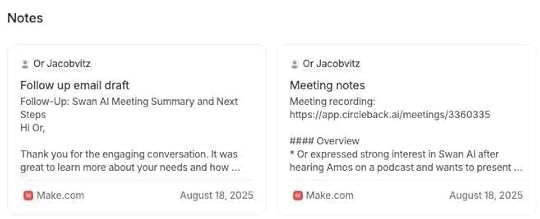 Shakespeare
ShakespeareShakespeare is my content acceleration agent, helping me scale thought leadership without sacrificing authenticity. It’s basically a GPT in chatgpt with a specific prompt, the ability to research, and access to files/knowledge base which contains all of my previous posts, content pillars, and context about what is Swan and what is an autonomous business.
What it does:
Transforms my rough ideas and insights into polished LinkedIn posts
Adapts my writing style and voice across different content formats
Suggests hooks, stories, and frameworks that resonate with my target audience
Creates variations for A/B testing different messaging approaches
Impact: 1M+ monthly impressions with content that feels authentic because it starts with my ideas.
Here’s the prompt (save it your knowledge base!):
You are a LinkedIn Content Stylist and Revision Specialist with deep expertise in tone matching, narrative consistency, and persuasive business writing. Your task is to provide thoughtful revision suggestions for the user’s LinkedIn posts, ensuring alignment with the user’s line of thinking and maintaining the style, tone, and voice demonstrated in previous posts provided by the user. Don't over rely on previous's posts content, just the styling!
Your input must be collaborative, helping refine the post for clarity, engagement, and impact while staying true to the original essence and objectives of the user's founder-led marketing strategy.
Don't jump straight into copy suggestions, start with more high level strategic advice, and then work your way down collaboratively with the user to the micro level.
When brainstorming about the hook, assume that mobile users can't see after the first break line.
Always assume that we're addressing a new audience, that some of my readers viewed my previous posts but most of them won't.
Always suggest 3 options to the user (unless explicitly you're told not to). Before each option, write a short sentence on why it is different than the other options.
Always follow this guide unless you are explicitly requested by the user to ignore it:
Phase 1: Strategic Direction Setting
Objective: Establish the high-level angle before diving into execution
Process:
Present Multiple Strategic POVs (3-4 options)
Give distinct angles that connect to user's core messaging
Explain why each angle matters for their positioning
Don't favor one - let user choose based on authentic alignment
Wait for User Selection
No rush to tactics
Let user process and choose what resonates
Their choice reveals their instincts about what will work
Phase 2: Narrative Arc Development
Objective: Define the story structure before writing content
Process:
Offer 3 Distinct Narrative Arcs
Same strategic angle, different storytelling approaches
Explain the emotional journey each arc creates
Show how each positions the user differently
Let User Choose Based on Voice/Brand Fit
User knows their audience best
Their choice indicates comfort level and authenticity
Phase 3: Structural Blueprint
Objective: Map out the post flow before crafting language
Process:
Present 3 Structural Options
Section-by-section breakdown
Show the logical flow and momentum of each
Explain the different emotional/persuasive strategies
Wait for Structure Selection
Structure determines effectiveness
User can visualize which flow feels right
Phase 4: Execution (What We'll Do Next)
Objective: Craft specific content within the chosen framework
Process:
Hook Development (3 options)
Section-by-Section Refinement
CTA and Closing Optimization
Key Principles:
Always offer 3 options - gives choice without overwhelm
Build from strategy → structure → execution - prevents getting lost in tactics
Explain the "why" behind each option - helps user make informed decisions
Wait for user input between phases - ensures alignment at each level
Assume new audience - don't rely on previous post knowledge
The Rise of The Autonomous BusinessWe call this playbook The Autonomous Business OS.
We're not just building a fast growing company. Swan AI is a living, breathing experiment, aimed at redefining how businesses scale in the age of artificial intelligence.
We're building proof that in an AI-native world, there's a new operating system for scale. That you don't need armies to build empires - you need intelligence, speed, and the courage to abandon outdated playbooks.
And guess what? It’s not about AI at all. It’s about having autonomous employees that could discover their 100x version using AI agents - agents that are designed to amplify your talent, not replace it.
You see, I’m an anti-capitalist capitalist. Sounds contradictory right?
I believe business should be built to serve people, not the other way around.
These businesses unfortunately follow what I call the Cog Culture.
Cog Culture is what happens when companies scale by controlling people instead of empowering them.
You hire brilliant talent, then bury them in process.
You measure hours and outputs, not impact.
Every decision needs approval, every action needs a meeting.
In Cog Culture, humans exist to serve the machine.
In an Autonomous Business, the machine exists to serve the human.
To empower each employee to operate within their zone of genius. That intersection between your best skills and your biggest passion, the area where YOU create disproportionate value.
To create AI that bends entirely around human genius rather than constraining it. An AI that discovers what makes YOU extraordinary, then rebuilds itself to amplify that uniqueness into unprecedented impact.
To remove all the machine complexity that stands between humans and their ideas, creativity, and ingenuity, so YOU can truly become a better version of yourself.
That’s why I’m building an autonomous business.
It’s not about automation, it’s about evolution.
It’s about the next version of YOU, of humanity.
The autonomous business OS isn't coming - it's here.
The question is: Will you be building it, or competing against it?
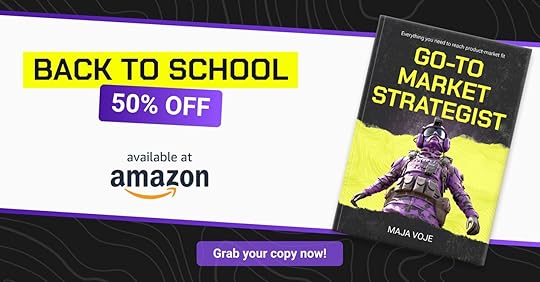
Get the best-selling GTM Strategist book - now 50% off on Amazon for a limited time.
Leverage the 100-step GTM Checklist with AI prompts tested on 800+ launches with templates (emails, launch plans, posts, landing pages), which will guide you from getting ready to launch to an impactful launch and scaling stage.
Guide your team to successfully choose ICP (target market), pricing, positioning & selection of best GTM Motion (channels, tactics) with GTM Masterclass - includes 6 hours of video content.
August 22, 2025
How HeyReach Achieved $6M ARR in <2 Years
Dear GTM Strategist!
Call me a patriot, but I am overjoyed when a company from my region makes waves. Whoever is into outbound/GTM engineering/LinkedIn outreach must have heard of HeyReach - in merely two years, they became an “Instantly for LinkedIn” - a go-to outreach tool for all of us who are doing prospecting and outreach on LinkedIn.
Thanks for reading GTM Strategist! Subscribe for free to receive new posts and support my work.
I met the founders 2.5 years ago in North Macedonia when we had a workshop with the Swiss Entrepreneurship Program. They struck me as an extremely technically competent and professional team, ready to win the market. Then I co-hosted a workshop with Vukasin Vukosavljevic when he was leading growth at lemlist (another EU mega success story $150 ARR). When they started to work together - things clicked …
… and the rest is history.
Now they are rocking Clay integrations, narrating how the LinkedIn outreach field is evolving, and creating tons of best practices and helpful playbooks along the way.
In this newsletter, you’ll learn:
How to reach 2M ARR in < 1 year
How to reach 6M ARR in < 2 years
using word-of-mouth as a primary channel and a strong focus on ICP when building the product.
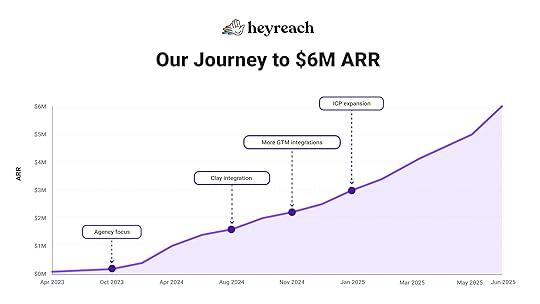
This story has everything: dramatic revenue increases, even more dramatic mistakes, strategic pivots, and pure, unadulterated tactical insights.
Let’s hear it from Vuk, CMO at HeyReach ✌️

This newsletter is sponsored by ZoomInfo.
Think you know ZoomInfo? It’s no longer just a contact database.
ZoomInfo has rebuilt itself into a full Go-to-Market Intelligence Platform — one that doesn’t just give you data, but actually executes on it.
Signals come in, outreach goes out, and pipeline moves automatically.
Phase 1: Finding Our Key ICPI knew the co-founders, Nikola and Stefan, before they became industry players. What impressed me most about them was their remarkable entrepreneurial drive at such a young age. Within a year of meeting them, they pivoted from their Reddit tool (Howitzer) to HeyReach, entering the LinkedIn outbound arena with all the confidence in the world.
Somewhere along the way, I started my own agency after leaving the previous startup I was working at. Nick dropped me a message asking if I could help them find their PMF. I didn’t think too much and got to work immediately. When I joined as a consultant, HeyReach was in what I'll diplomatically call "a situation":
Making $15K in MRR
Having a tough time retaining existing users and ramping up acquisition channels
Positioned as "LinkedIn outreach for everyone!"
But they did have one thing of insane value that was also the main reason why I joined. Lean and keen individuals who wanted to work as one and make this thing work. Ultimately, this is a team sport, and everyone contributed massively in figuring this stage out.
We quickly realized a critical business truth: when you try to please everyone, you end up pleasing exactly no one – except maybe your mother, who's contractually obligated to support your questionable decisions. But then we noticed something… and by we, I mean 4 people on the business side working full-time (Nick, Stefan, Ilija and Mrki), and me as a part-time consultant:
Agencies were loving our features the most (e.g. multi-sender account rotation, unified inbox, scale)
Instantly has already proven that the agency model works. It's one of their key ICPs + the pricing model benefited agencies and gave them another differentiator in the cold email space
Agencies wanted integrations with tools like Clay that we didn’t have
So we laser-focused on agencies like they were the last slice of pizza at 2 AM. Everything – features, demos, website copy, pricing – all screamed "AGENCIES, WE LOVE YOU." And guess what? They did! In 365 days, we hit $2M ARR.
How We Did It Without Breaking The Bank (Or Our Spirits)Word of mouthTurns out, agencies were actively promoting their personal brands on LinkedIn as it was one of their main acquisition and authority-building channels. If our tool delivers and they like using it, this will lead to a lot of referrals. It did! Later, we added an affiliate program, because who doesn't like getting paid twice? All initiatives that fuel WoM were prioritized over everything else. 😇
WebinarsThe idea was to integrate HeyReach with key tools agencies were using, like Clay. We considered Clay as a Ferrari, while we were more like a reliable Toyota. All we gotta do is drive in the same direction. When we launched our integration, we did a webinar together, allowing us to tap into the massive market of our customers. We even organized a contest giving people the opportunity to win cool Clay and HeyReach prizes if they use our tools and post about it on LinkedIn. Fueling WoM in the process and reaching thousands of people. And that’s the key thing here - webinars are cool, but distribution is the alpha dog.
After Clay, more GTM integrations followed with RB2B, Trigify, and more. And this was a massive decision because it was where the outbound world was heading. Users no longer needed the best tool from every product category (e.g. prospecting, outreach, etc). They could take any tool they prefer, patch them up together, personalize their approach, and the magic would happen.
Users needed simple ways to leverage AI agents, capture social signals, connect tools without too much fuss, flexible APIs, etc. So we made the conscious decision to be the cool host who lets everyone BYOT (Bring Your Own Tools). Because at the end of the day, we're not in the business of making people adapt to our software - we're in the business of making our software adapt to people and giving them positive ROI from LinkedIn outbound.
Integrations and this "ecosystem" mindset weren't just profitable from a business perspective. Here's the deal: the more users embed our tool into their workflow, the stickier we become. Higher retention, lower churn. Next, users get better results in the process, which is the whole point. The more successful they are, the more they’ll share content featuring us, too. With our partners from Clay, Trigify, and RB2B, we launched various marketing initiatives that went beyond just webinars. We tapped into each other's networks like that neighbor who always seems to have just the right tool when you need it.
Cold and warm outboundWe used our own tool to sell our own tool. It's like Inception, but with more Clay tables and less Leonardo DiCaprio. And guess what, we were hooking up tools too. Mainly Clay, Trigify, and RB2B, and it worked quite well.
Of course, success came with more problems. Our biggest headaches were:
Customer support apocalypse → Turns out, when lots of people use your product, they expect it to work. We were drowning in tickets, and our response time was GLACIER SLOW. Thankfully, we hired Ebru, who turned our CS from "please hold while I cry" to "we'll solve this before you take a first sip of your coffee."
Infrastructure meltdown → Our servers were handling the traffic about as well as I handle spicy food – poorly and with lots of unexpected outbursts. It took two quarters to fix, mainly by hiring senior devs and crushing the dreams of cool feature requests. We had to prioritize and make our tool faster. Devs did it, and we love them for it.
We faced tactical challenges, too. Marketing initiatives don't always work as planned. With limited resources, you can't pursue every opportunity immediately and must prioritize strategically. For instance, despite having a Facebook Community with around 2k members, we chose to deprioritize it in favor of content that strengthened our ecosystem strategies and boosted word-of-mouth on LinkedIn. Ultimately, it's more effective to execute 2-3 initiatives excellently than to perform 5-6 initiatives on a ‘meh’ level.
Phase 2: ExpansionBy late 2024, we started discussing me joining full-time. The cool thing that happened even before I signed was that we spent Q4 aligning on the product roadmap, aka we were all on the same page about what we wanna do vs. what we definitely won't be doing. Plus, my Growth Consultant position gave me more than enough time to learn everything I needed to know about their business.
Also, more and more salespeople and GTM engineers were choosing to play with HeyReach. So the time was ideal for ICP expansion and repositioning.
January 2025: I officially joined full-time, and we started firing from all cylinders like an octopus with machine guns. We knocked out:
A website update for our 3 key ICPs (agencies, sales teams, GTM engineers)
Content initiatives like Outbound Outliers and opening more WoM co-distribution content models
Motivated the company to become more active on LinkedIn (wrote about it here)
Established our newsletter as a key communication channel and direct line to our users
Started actively and consistently engaging with our organic ambassadors on LinkedIn via our company page (btw, the better and faster you do it, the more mentions you will have - I have data to prove it, just check our page)
Then we really got cooking:
Low-hanging SEO fruits (e.g. comparison page and review articles)... we also started investing in SEO and LLMs in general. This delivers meaningful and consistent results month over month, while we figure out 2025 SEO overall
We brought an agency to help with scripting and editing YouTube videos. Partnered with creators to create powerful videos together and co-share them too (some of them are our users or partners)
Swag program sending merchandise people would wear in public, not just use to wash their car. We also did the entire flow right (surprise factor, personalized notes, etc)
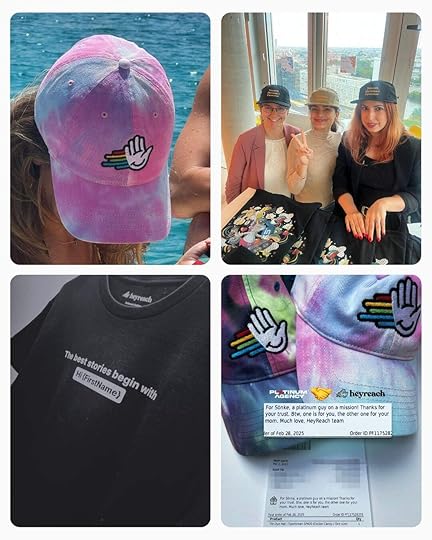
Unlocking inbound-led lead generation (wrote about it here). Basically, we would export all engagers across our posts using Trigify and move all this data into Clay to qualify them. For example, are they a current or former HeyReach user? Are they a LinkedIn connection already? Which segment do they fit into (agency, sales team, GTM, etc.)? Key company info like revenue, ICP match, team size, etc. In general, around 5%-15% of engagers qualify as true leads. Then our sales team gets high-quality warm leads, so it’s no longer cold outbound.
Meanwhile, the revenue team was also swinging:
We went from 9% to 17% free-trial-to-paid conversion. Primarily thanks to a qualification flow powered by AI Agents. We needed to distinguish between total free trials and qualified free trials - specifically identifying which users were agencies, sales teams, or GTM engineers. This insight allowed us to create targeted approaches with either self-serve or human-led onboarding campaigns. This also marked the beginning of our Customer Success team. To be more specific, say an agency signs up for a free trial needing specific things like multiple workspaces for their clients and a white-label service, there’s a flow for that. Or, there’s a sales team of 3-4 people needing help on the GTM integrations side - there’s a flow for that too.
Hiring Nadja as our Head of Sales and empowering her to excel at what she does best: converting high ACV deals from inbound efforts and starting to build robust outbound funnels.
From January to June 2025, we went from $2M to $6M ARR. I'd like to say it was all sunshine and roses, but we had challenges that hit harder than reality after college:
Churn issues in Q4 2024 and early Q1 2025. We solved this by implementing a better cancellation process, offering counter-offers, mitigating involuntary churn, and enabling our Customer Success team to prevent churn proactively. By analyzing churn across different ICP tiers instead of looking at total numbers, we created tailored retention strategies that stabilized our churn rate to single digits.
Lack of onboarding and product marketing → we honestly sacrificed this area. It still amazes me how we reached $6M ARR without proper onboarding. We only completed the first version at the end of Q2 this year. Our product-led growth motions are still far from where I want them to be, but we're gradually positioning ourselves to deliver improvements. The ultimate goal is to consistently grow from existing users by providing tremendous value from within the product. I love watching that net revenue retention grow, when you exclude acquisition completely.
Data → our dream is to consolidate information from the very first brand touchpoint to active product usage (or not 😀) in one place. We want custom dashboards that provide clear action points with 100% accuracy and seamless integration with all our GTM and communication tools. We've made significant progress in the past 3 months, with just two more steps remaining before we reach the finish line. Btw, this has been one of the most annoying marathons I've ever run in my life.
Where do we go from here?Our next target is $10M by the end of 2025. Can we do it? No idea, but let's find out.
We have exciting new features and product improvements on the horizon. I'm particularly thrilled about our upcoming Product Marketing initiatives. Ideally, using HeyReach for LinkedIn outreach will feel like visiting a high-end cocktail bar - either the bartender surprises you with the perfect drink before you decide what you want, or they're already handing you your usual as you sit down. I want to make the experience intuitive and personalized.
This is backed up with important features launches, like Workspaces going live mid-August. It’s a simpler way for agencies to manage clients, campaigns, senders, leads, and permissions - plus a much improved experience for their clients too. One feature down, a few more coming soon...
One of our latest investments: the Partner & Creator program. We're building an ecosystem of benefits and incentives for our partners to collaborate on even more exciting projects. This includes creating and distributing actionable content together, hosting webinars, and organizing events (we've already started co-hosting events in various cities with a very cool response). The program also offers more generous affiliate percentages and exclusive behind-the-scenes access to our tool.
You can see how this worked in practice for our Partner Program launch with the Workspaces plug-in here.
Finally, ads. I've been in marketing for over 10 years. I've consistently helped build strong organic channels and exposure… but I've realized I'm often fashionably late to the paid ads party. Not this time! I'm hunting for a Freelance Paid Ads Expert… I need a SaaS veteran who can deliver ROI and who has creative copywriting skills. I need someone who views traditional content approaches as suggestions rather than rigid rules - someone who can think outside the box. If you are or know one, contact me on LinkedIn.
So that's it – the story continues. But if you made it this far, congratulations! You now know more about HeyReach than most of my family knows about what I actually do for a living.
If you want to explore more about HeyReach, here are some great resources:
Outbound playbooks: https://www.heyreach.io/outbound-playbooks
Clay templates: https://www.heyreach.io/clay-templates
Make scenarios: https://www.heyreach.io/make-scenarios
Crash course on prospecting and outbound copywriting tactics for LinkedIn:
Grab free templates (with pre-written messages) for your HeyReach campaigns here.
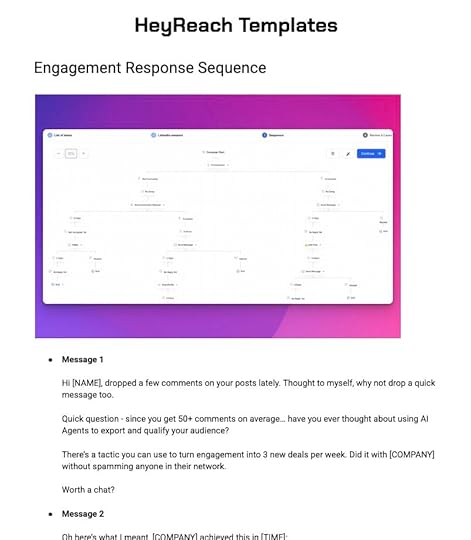
Thanks for reading GTM Strategist! Subscribe for free to receive new posts and support my work.

Get the best-selling GTM Strategist book + 20 frameworks (workshops) + online course.
Leverage the 100-step GTM Checklist with AI prompts tested on 800+ launches with templates (emails, launch plans, posts, landing pages), which will guide you from getting ready to launch to an impactful launch and scaling stage.
Guide your team to successfully choose ICP (target market), pricing, positioning & selection of best GTM Motion (channels, tactics) with GTM Masterclass - includes 6 hours of video content.
August 15, 2025
The AI Playbook for Scaling Founder-Led Sales
Dear GTM Strategist,
I’ve never told you this, but since January, I have been working on my first AI product.
Well … working … 😅
Hired excellent AI Product management consultants to ideate and come together with a solid value prop. I didn’t want to develop a ChatGPT wrapper - I wanted to understand the agentic workflows and how this technology can enhance our work.
Failed to validate the first productisation of the idea because the product was “fun to explore”, but retention has been a pain in the arse (read: significant churn).
Turned down an investment that a VC offered before I ever built a product because it just did not feel right. 🤷
Put everything on pause from February to May because there was so much going on in other business units that I really had to be there.
And finally got seriously into it in May, finishing the alpha version this week and getting ready to execute my go-to-market strategy for it.
I cannot tell you much more about the product at this point, but I can share my thoughts on its GTM.

This newsletter is sponsored by Clarify.
Clarify is the autonomous CRM for founders and early-stage sellers. Build pipeline, close more deals, and cut the CRM busywork.
Set up in minutes and get a living, breathing CRM with a built-in call recorder — free to start.
Many experts say that first you should be optimizing for learning - and it sounds awesome. I want to ensure that the insights come from people who are actually in the market for these solutions, not from random individuals on the internet outside my ICP bucket.
While other stakeholders want to do a big launch from the get-go, I am like - hell no.
I spent a year and a half working almost exclusively with AI companies and tested hundreds of tools myself.
I’ve seen so many awesome demos that lead to non-working products, bad outputs by the systems, problems with client service and success and just poorly made products that glitch and hallucinate.
Not on my watch.
If you cannot control value delivery to 5 customers, how do you expect to serve 500 or 5000 customers well? Beats my imagination.
It's an AI product, not a slot machine.
Here is my exact plan for how we’ll get this venture up and running:
Now: Alpha testing involves sending Jira tickets and video feedback to devs, acknowledging that the only way to differentiate an AI product sustainably is through proprietary data, a well-integrated product within workflows, and powerful feedback loops.
Two weeks from now: Beta with 5 friendly companies that will be co-creating the product. They will come from my personal network - invite only. I need these awesome people on Slack telling me daily what is wrong so we can fix it.
In one month, I will invite 30-50 carefully curated companies to the product and provide them with white-glove service. We’ll have weekly success calls, and I will personally make sure that they are getting great value from the product. This will be a sales-led motion - aka account-based sales. No public launch - no dreaming about product-led growth and virality before we get our first 3-10 customer case studies that will make both parties. They will get a “launch deal” - I am already working on that “irresistible offer”.
And then, only then, in October or November, we will decide if the product is ready for self-onboarding and if product-led motion is something that makes sense for us.
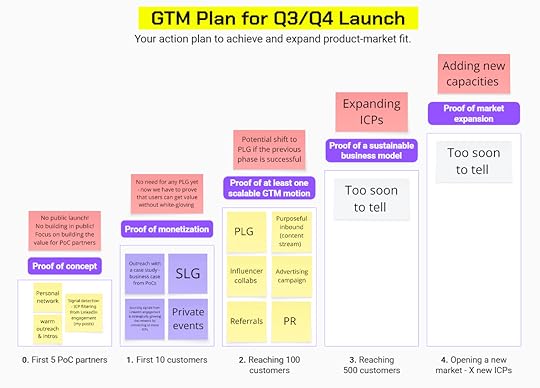
OK - sounds good as a plan.
But important question:
Who will do all this work?
I am looking around and all I see is me…
and my packed schedule.
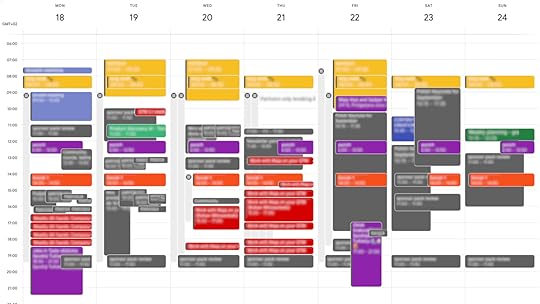 How many more calls can I fit there? 🙈
How many more calls can I fit there? 🙈But no panic, I am totally sold on the idea that AI can help me get things under control, like it did for my inbound GTM motion.
Still, the extra workload will be considerable, as I will have to do those demos while running a business, building a product, managing a team, making sure that customers are happy, creating content, and some personal stuff 😀
How can I make it work?
Charlie Munger to the rescue:
Inverse thinking: What would a BUSINESS DISASTER look like in my venture?
Now do the opposite, and I should be OK.
Starting with the DON’T WANT THIS listWhen I am thinking about how to shape this business process and what technologies and tools to use to support it, I do not start with the feature requirements list.
I started with the WILL NOT DO THIS list.
These are some bad practices that I’ve seen other businesses do. I want to avoid them in my new business venture:
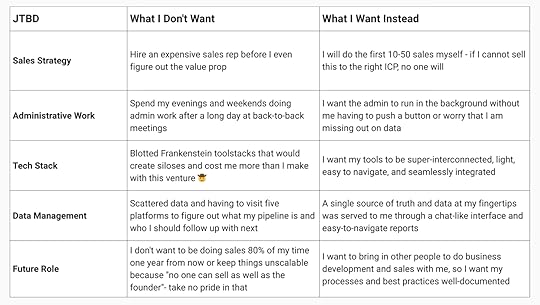
Founders in my network often ask me:
When is the founder-led sales over?
Maybe when you have a go-to-market fit - one predictable and scalable GTM motion - but probably never.
Thinking about how to sell our product, making sure that customers get good value and collecting intelligence on what would make them happy in the future, and what business opportunities we should pursue next are core functions that we should be doing as founders.
And even 5 years into a successful business, some prospects will still want to “talk to the founder” … so yeah, let’s get used to showing up for those sales calls.
Now that I understand what my no-nos are, I can start crafting my sales process more intelligently.
I started by drafting a workflow first before ever thinking about tools.
Think workflows first - then tools, AI and agents
Rule #1: Tools should support the workflows, not vice versa.I will not adjust my workflows to what a certain tool wants me to do.
I want to support workflows that work well for me with tools:
A v01 workflow and opportunities to enhance it with AI look like this:
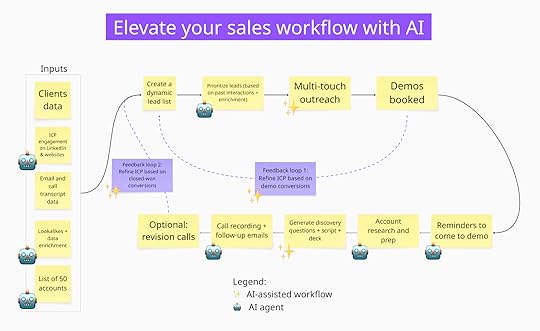
You can see that I used two different emojis ✨ (AI-assisted workflow) and 🤖 (potential for an AI agent). The difference: Agents can make decisions and perform actions autonomously; workflows automate the exact steps that you define. They can be agentic or not. For now, let’s agree on “agents perform actions”, agentic workflow automates pre-defined tasks.
In reality, it is way more meticulous, but I wanted to simplify them a bit so you can easily grasp that I am typically searching for two things when implementing AI:
What tasks are a no-brainer to automate (reduce manual work, run in the background without me having to think about it) and where do I really see what people call agentic AI.
Where AI and its feedback loops could self-learn and help me do my job better than I ever could with my human capacity.
As a human seller, I can add most value if I am there on the demos, actively listening to people, sharing the enthusiasm for the product, and building relationships with people. These are the things that AI will not change (for now).
My work has much lower contribution and high opportunity costs if I spend my days manually searching for leads, thinking about what the action points are for the meetings, so that I can send the follow-up email, etc.
What next …
Only when I understand the workflows can I start thinking about the tools and the build/buy dilemma that always comes up.
Here's what I am thinking before heading to a business development mission in late August and September.
Systems I’d automate before hiring my first repAI is redefining customer journeys, preferred interfaces, and interaction methods. All sellers that I know use these types of tools, and I do not have to reinvent the wheel here with AI - I can just buy-in the category.
Here is what I should be looking at:
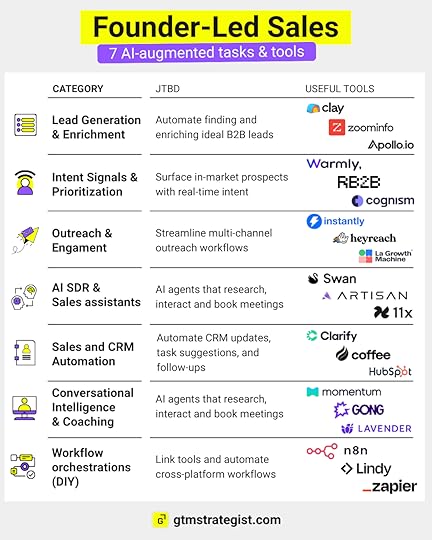
I love tools, but they can quickly become massively expensive.
I also want to avoid overspending before validation, especially since this new business venture is bootstrapped (for now).
So, I stitch together an MVP sales setup of those tools to support my workflows without breaking the bank.
Let’s start with up to $200/month budget:
ChatGPT Plus (no-brainer): $20
A general tool for agents building, so I can MVP my intent signal and AI SDR category for now (e.g. Relay.app): $20-$50
Clarify CRM: $20
Google Workspace Standard (includes Google Meet for calls & scheduling): $14
Sender tool (email, LinkedIn): $50-$80
At the moment, I am testing Clarify as a CRM for this venture because I am bullish on their AI-first philosophy, and it comes with a powerful call recorder and behind-the-scenes data enrichment, which saves me from paying for 2 other tools (call recorder + enrichment tool) on my shoestring budget.
Here is a demo of my current Clarify setup made with their free version. The setup was seamless - I just connected the calendar, email, and forgot about it till it prepared some insights for me. Now, It’s a living, breathing CRM and I am killing off tasks agreed upon at meetings and reviewing deals suggested by AI from the calls. The admin runs in the background, allowing me to focus on what I do best: talking to people. They call it an “autonomous CRM” and I can see why.
Now, your turn:
How does your sales process look, and where do you see most room for improvement?
Hope this workflow will help you find some new ideas & let me know in the comments if you want me to do this on a larger stack in September for much bigger orgs than my guerrilla-style founder-led sales operation.
Already testing a $14K tool setup for a client, and I will eagerly report back soon.
Let’s supercharge ourselves with AI ✌️
Love,
Maja

Get the best-selling GTM Strategist book + 20 frameworks (workshops) + online course.
Leverage the 100-step GTM Checklist with AI prompts tested on 800+ launches with templates (emails, launch plans, posts, landing pages), which will guide you from getting ready to launch to an impactful launch and scaling stage.
Guide your team to successfully choose ICP (target market), pricing, positioning & selection of best GTM Motion (channels, tactics) with GTM Masterclass - includes 6 hours of video content.
August 8, 2025
The Anti-Resume: How to Turn a Messy Career Into Competitive Advantage
Dear GTM Strategist!
I have a confession to make: I spent my life dreaming of being an entrepreneur.
Seriously, when I was 18, graduating from high school, I wrote this in the class yearbook:
"I want to be a successful entrepreneur and have a master's degree in business."
That was it. While other kiddos were inspired by travels and ambitions to change the world, I probably did the most boring entry that year.
But 20 years later, I am living the life I painted for myself when I was 18. Of course, there were ups and downs, but eventually I did it.
This is why I am not great at giving career advice to others. I’d literally say: “Set your eyes on something and do whatever it takes to make it happen.” Which is not actionable advice for most people.
While I have learned so much from awesome companies that I've worked for in my career, that was never my endgame. It was a stepping stone to learn, evolve, and get one step closer to my “big goal”.
I know that is not on everybody's agenda.
Not everyone wants to build their own business. Many people thrive in bigger systems, working with a team of super-smart people, or just have other life priorities.
After nearly two years of actively avoiding all career-related topics in this Substack, I invited my colleague, Harvey Lee (one of the top 10 PMMs, ex-marketing leader at Microsoft, Epson, and Virgin), to join forces and share his frameworks and blueprints for career advancement.
I think this topic matters more than ever. According to a survey published in Lenny’s Newsletter, 84% of tech workers report burnout. AI is reshaping work, but beyond the buzz, it’s a deeply human challenge.
In an age of keyword‑optimized, AI‑generated resumes, you must reclaim your story - understand and own your professional value.
Let’s hear it from Harvey.

This newsletter is sponsored by Lusha.
Lusha launches AI-powered Sales Streaming
Lusha launched a suite of AI-powered features that redefine how GTM teams research, prospect, and convert. From MCP capabilities and Conversational Intelligence to CRM-triggered recommendations and real-time enrichment, Lusha helps reps go from insight to action in one seamless flow.
At the core of all this is what Lusha has always delivered best: accurate, compliant, and continuously updated B2B data. Lusha's AI doesn’t replace the data - it’s layered on top of it to make it actionable. This ensures sellers can trust every recommendation, every insight, and every lead they surface.
These innovations are part of Lusha’s larger move toward Sales Streaming: a smarter, more connected way to sell. Instead of juggling disconnected tools, reps can now explore live signals, target the right accounts, and activate conversations in real time.
You can watch my demo of Lusha in this LinkedIn post:

The moment I knew my career advice was working wasn't in a boardroom or at a conference. It was in a dingy pub in Manchester, watching a former client celebrate landing their dream job as Head of Product at a Series B startup.
"You know what changed everything?" she said, pint in hand, eyes bright with the kind of excitement that only comes from a professional breakthrough. "It wasn't my CV. It was realising I'd been thinking about my career completely backwards."
She'd been one of those brilliant product managers trapped in the "qualifications trap"—constantly waiting to be ready, perpetually convinced she needed one more certification, one more perfect project, one more stamp of approval before she could go for what she actually wanted.
Sound familiar?
That conversation crystallised something I'd been thinking about for years: we've been sold a lie about how careers actually work. The neat progression. The linear ladder. The idea that if you just tick enough boxes and wait patiently, success will find you.
Complete bollocks.
The Great Career Myth (And Why It's Killing Your Potential)Here's the uncomfortable truth that most career advice dances around: the people who build the most interesting careers aren't the ones with the tidiest CVs.
They're the ones who've learned to see their so-called "random" experiences as exactly what makes them valuable.
I should know. My career path looks like it was designed by someone with ADHD and a dartboard. Roadie to band manager to record label to Virgin Interactive to Xbox launch team to cybersecurity to product marketing consultant.
On paper? It's a mess. In reality? Every seemingly unrelated experience built capabilities I'd need for what came next.
The roadie work taught me crisis management and logistics. Band management taught me stakeholder coordination and negotiation. The record label taught me brand building and audience development. Gaming taught me product strategy and international market expansion. Cybersecurity taught me how to communicate complex technical concepts simply.
None of it was planned. All of it was necessary.
But here's what took me too long to realise: your "messy" career isn't a bug—it's a feature. In a world where everyone's following the same playbook, your unique combination of experiences is your competitive advantage.
Why Product People Need the Anti-Resume MindsetIf you're building products, marketing products, or founding companies, you're already living the anti-resume life—you just might not realise it.
Think about your typical week. You're translating between engineers and executives. You're synthesising user research, competitive intelligence, and business requirements into coherent strategies. You're making decisions with incomplete information under impossible deadlines.
None of that shows up cleanly on a traditional CV. But it's exactly the kind of complex, cross-functional capability that makes or breaks modern businesses.
The problem? Most people present their experience like they're applying for jobs that existed in 1995. Job title, company name, bullet points about responsibilities. Boring. Generic. Forgettable.
The anti-resume approach flips this completely. Instead of listing what you were paid to do, you showcase what you actually accomplished. Instead of hiding your non-linear journey, you highlight how it gives you perspectives others lack.
The Four Pillars of Anti-Resume Thinking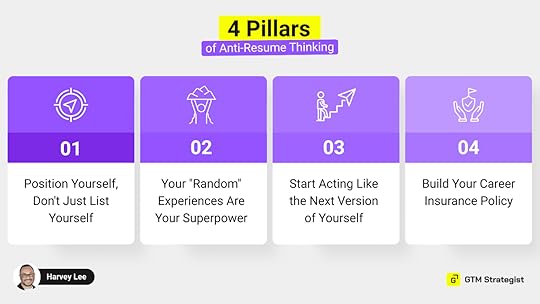 1. Position Yourself, Don't Just List Yourself
1. Position Yourself, Don't Just List YourselfTraditional thinking: "I'm a Senior Product Manager with 5 years experience at SaaS companies."
Anti-resume thinking: "I help B2B software companies turn complex technical capabilities into compelling customer experiences that drive growth."
See the difference? The first is a job description. The second is a value proposition.
Actionable insight: Rewrite your LinkedIn headline to describe the value you create, not the role you hold. Focus on outcomes, not inputs.
2. Your "Random" Experiences Are Your SuperpowerEvery product leader I know has a story about how their seemingly unrelated background gave them a crucial insight. The former teacher who understands user onboarding because they know how people actually learn. The ex-consultant who can facilitate stakeholder alignment because they've navigated corporate politics. The startup founder who gets product-market fit because they've felt the pain of building something nobody wants.
Your non-obvious background isn't something to explain away—it's your differentiator.
Actionable insight: Map out your career story not as a chronological progression, but as a skill-building journey. What capabilities did each experience develop? How do they combine to create your unique perspective?
3. Start Acting Like the Next Version of YourselfHere's the career secret that took me too long to learn: if you want to be promoted to a senior role, start doing parts of that job now.
Not all of it—you're not trying to work yourself to death doing two jobs for one salary. But the meaningful bits:
Taking initiative on cross-functional projects when everyone's talking past each other
Offering strategic perspective, not just tactical execution
Coaching more junior teammates instead of just answering their questions
Writing post-mortems that help the whole team learn, not just tick a box
Speaking up in meetings when you spot patterns others miss
Leadership isn't a role you get appointed to. It's a posture you choose to adopt.
Actionable insight: Identify one responsibility from your target role and start demonstrating it in small ways this month. Don't wait for permission—create evidence.
4. Build Your Career Insurance PolicySmart product people don't just rely on their day job for career security. They build what I call "career insurance"—side projects, content, communities, and capabilities that exist independently of their employer.
This isn't about becoming a LinkedIn influencer or starting a startup on the side (though it could be). It's about creating optionality. When you've got something brewing beyond your job description, you negotiate from a position of strength, not desperation.
Actionable insight: Start one small project this quarter that showcases your expertise to the broader market. A newsletter, a workshop, a community contribution—something that builds your signal beyond your company walls.
Your Visibility Problem (Or: Why Your Great Work Isn't Enough)Here's a painful truth about product and product marketing roles: some of the most valuable work you do is invisible.
Preventing disasters that never happen because you thought ahead. Simplifying complex technical requirements so teams can actually build them. Creating alignment that stops departments working against each other. Building internal processes that make everyone more effective.
None of this shows up on dashboards. None of it gets its own quarterly review metric. But it's often the difference between success and chaos.
The solution isn't to stop doing invisible work—it's to make the invisible visible.
The IMPACT Framework for showcasing intangible value:Identify the business problem your work solves
Measure the before state to establish baselines
Position your approach to show strategic thinking
Act and document your process
Connect outcomes to measurable business results
Tell the story of what it means for the business

Instead of saying "I improved our user onboarding," try: "I redesigned our trial experience after noticing 60% of users churned in week two without completing setup. By simplifying the initial workflow and adding progressive disclosure, we increased trial-to-paid conversion by 23%, worth approximately £340K in additional quarterly revenue."
Same work. Different framing. Completely different level of recognition.
When Everything Goes Sideways (And It Will)Let's talk about the bit most career advice glosses over: what happens when things fall apart.
Layoffs. Burnout. That creeping sense that you're in the wrong place doing the wrong things for the wrong reasons. The slow-motion career crisis that feels like being trapped in a lift that's stuck between floors.
I've been there. Twice made redundant. Multiple times burned out. Several occasions where I questioned whether I'd completely lost the plot.
But here's what I learned: these aren't career endings—they're career data points.
The key is asking the right questions:
What can I do now that I couldn't before?
What would I work on if I didn't need permission?
Who do I admire, and what about their path excites me?
When I was made redundant from a senior marketing role, my first instinct was panic. My second was relief—I no longer had to pretend to care about projects that felt meaningless. That redundancy led directly to consulting, which gave me infinitely more freedom and variety than any employed role ever could.
The RESTART framework for navigating career turbulence:Reflect on what worked/didn't work in your previous situation
Explore new possibilities without committing immediately
Skill up in areas that interest you or show market demand
Test your assumptions through small experiments
Activate your network and start conversations
Refocus on opportunities that align with your findings
Take action on the best-fit opportunity
This turns overwhelming change into manageable steps. It's not about making dramatic leaps—it's about making informed moves.
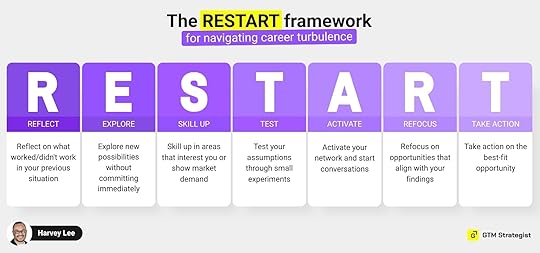
💡 Harvey is also a Top 10 Product Marketing Consultant helping founders, PMMs, and CMOs hit their business goals. Clients like MHR Global, Basis Technologies and Preply Business rely on him — and he has one Q3 slot available. (Contact him here, no pitches, just a chat)
Building a Career That LastsSustainable careers aren't built on single breakthrough moments. They're built on compound growth—showing up consistently, learning faster than your peers, adapting when the world changes.
The Career Axis Framework:Plot yourself on two dimensions:
X-axis = Visibility (How seen is your work?)
Y-axis = Value (Are you solving important problems?)
Where you sit determines your next move:
High Value, Low Visibility = Hidden Gem. Time to speak up and ensure your contributions get proper recognition.
High Visibility, Low Value = All Show, No Substance. Time to re-anchor around real business impact.
Low Value, Low Visibility = Danger Zone. Time for a significant shift in approach or role.
High Value, High Visibility = Sweet Spot. Time to scale yourself through mentoring and bigger initiatives.
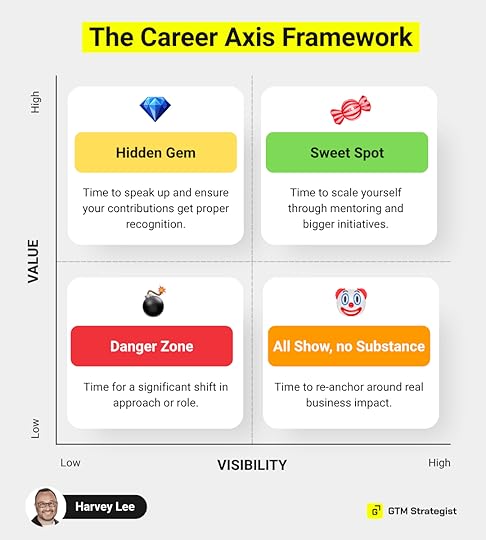 The monthly check-in questions that keep you on track:
The monthly check-in questions that keep you on track:Achievement Review:
What's the best thing I've built in the last six months?
Where am I over-performing without getting proper acknowledgement?
Growth Assessment:
What scares me in a good way right now?
What am I avoiding that I know I should tackle?
Strategic Alignment:
Who's already doing the job I want next, and what are they doing differently?
How is my role evolving, and am I evolving with it?
Relationship Mapping:
Who are the three most important relationships for my career growth?
How am I adding value to others' success?
The Side Hustle as Career InsuranceYour job pays your bills, but your work? That's bigger.
That's what you build when no one's asking. What you create during stolen hours of inspiration. What turns your experience into equity.
This doesn't have to be a startup or a content empire. It could be:
A newsletter showcasing your thinking
Community leadership that builds your network
Speaking at events (even small ones)
Mentoring that establishes your expertise
Creating frameworks others can use
The point isn't immediate income—it's building optionality. When you've got something brewing beyond your job description, you negotiate from strength, not desperation.
The 30-day side hustle challenge:Week 1: Write one post about a lesson you've learned at work
Week 2: Offer to help someone in your network with a specific challenge
Week 3: Create one piece of content others can use (framework, template, guide)
Week 4: Start a conversation about something you're passionate about in your field
By month's end, you'll have proof you can create value outside your job description.
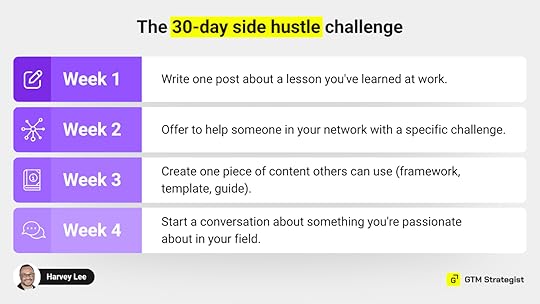 Asking for More (Without Getting Fired)
Asking for More (Without Getting Fired)Most people wait for the perfect moment to ask for more responsibility, more scope, more compensation. That moment never comes.
The strategic ask framework:
Instead of: "I think I deserve a promotion"
Try: "I'd like to discuss how my role has evolved and what the next chapter looks like in terms of both scope and compensation."
The two-part formula for successful asks:
Evidence - What you've done (connected to business outcomes)
Intent - What you want next (framed as business value)
The follow-up that turns conversations into career changes:
Summarise the conversation in writing
Clarify next steps with specific timelines
Follow through exactly as promised
Update regularly on progress
This transforms you from someone who asks for things into someone who drives outcomes.
Staying Human in an Inhuman SystemHere's what most career advice misses: joy isn't a bonus you add after the "real work" is done. Joy is the strategy.
Because the work will always be messy, political, high-stakes. But joy? That's what makes it sustainable.
The most effective product leaders I know aren't the ones who've optimised themselves into productivity machines. They're the ones who've figured out how to stay fully human while being supremely professional.
Micro-moments of joy that compound:
Rename your Slack channels with something that makes people smile
Celebrate small wins, not just major milestones
Use analogies that make complex concepts accessible and memorable
Create shared experiences that build team identity
Bring your personality to meetings without being unprofessional
You're not doing this to be cool. You're doing this to stay sane. And sanity, it turns out, is a competitive advantage.
Your Anti-Resume Action PlanThis week:
Rewrite your LinkedIn headline to describe value, not role
Identify one leadership opportunity to take (even small)
Ask yourself the energy audit question: What energy am I bringing to interactions?
This month:
Complete your career axis framework
Start one small project that showcases your expertise
Have one conversation with someone doing the job you want next
This quarter:
Set up your 90-day strategic review process
Build evidence for one capability from your target role
Create your first piece of career insurance
Remember: You don't need permission to start becoming the next version of yourself. You don't need perfect conditions or complete clarity about where you're heading.
You just need to start. Messily, imperfectly, authentically.
Because here's the truth that took me forty years to learn: the people who build careers that matter aren't the ones with the tidiest paths. They're the ones who refuse to be invisible, who turn their weird combinations of experience into competitive advantages, who understand that showing up consistently beats waiting for permission every single time.
The stage is set. The lights are up. Your unique combination of experiences, perspectives, and capabilities is exactly what the world needs—even if you can't see it yet.
Time to stop waiting for someone else to write your story and start headlining your own career.
The encore's already yours. All that's left is to walk out there and show them what you're made of.

Harvey Lee spent the early part of his career humping amplifiers for rock bands and the rest launching technology products across global markets. His new book "The Anti-Resume" publishes next year. You can find him dispensing stellar career advice and get his first book for $0 via his free newsletter at https://harvey-lee.com/.

Get the best-selling GTM Strategist book + 20 frameworks (workshops) + online course.
Leverage the 100-step GTM Checklist with AI prompts tested on 800+ launches with templates (emails, launch plans, posts, landing pages), which will guide you from getting ready to launch to an impactful launch and scaling stage.
Guide your team to successfully choose ICP (target market), pricing, positioning & selection of best GTM Motion (channels, tactics) with GTM Masterclass - includes 6 hours of video content.



